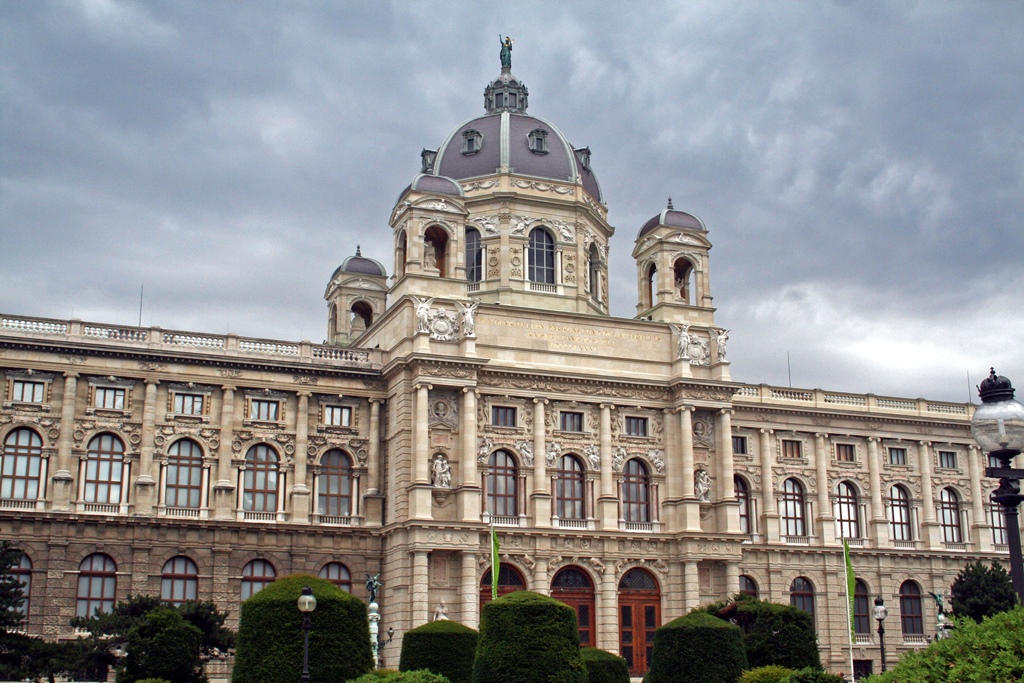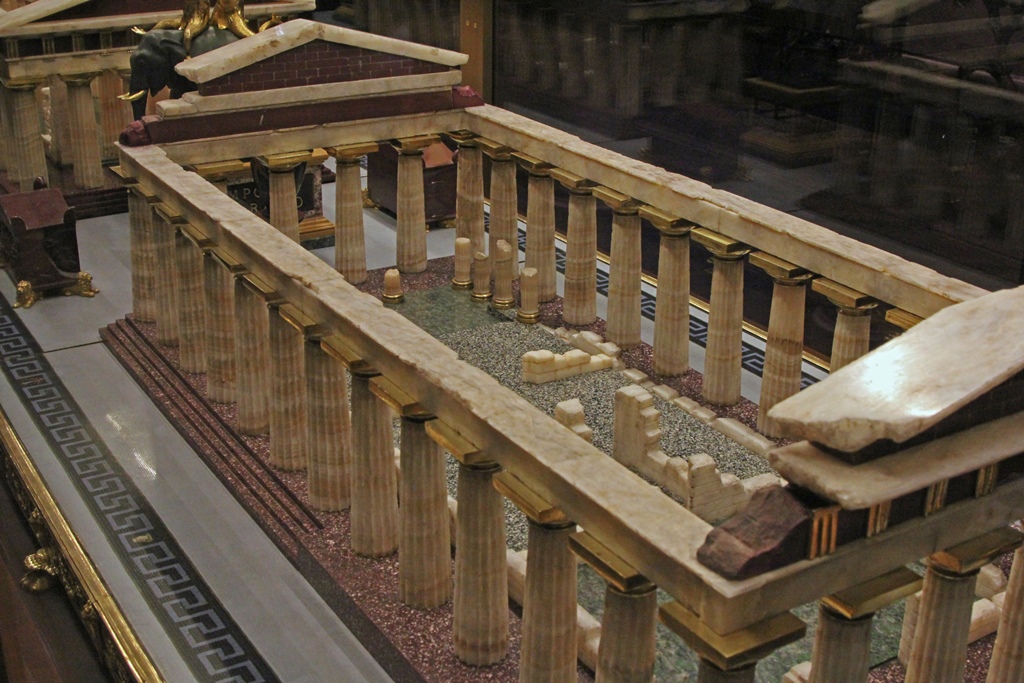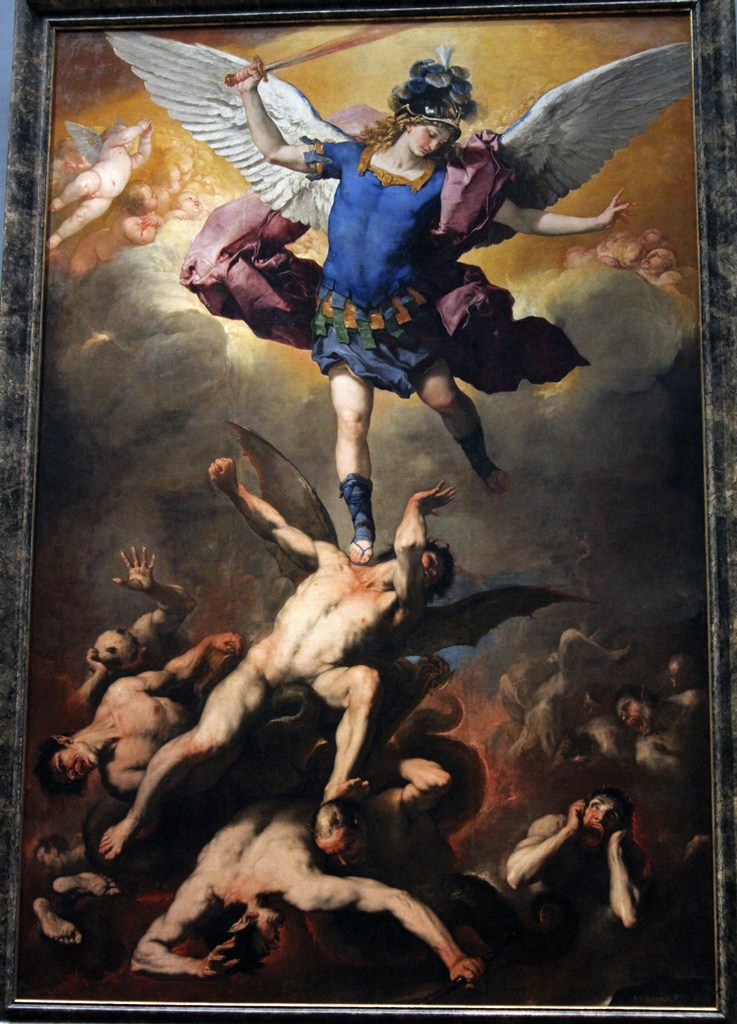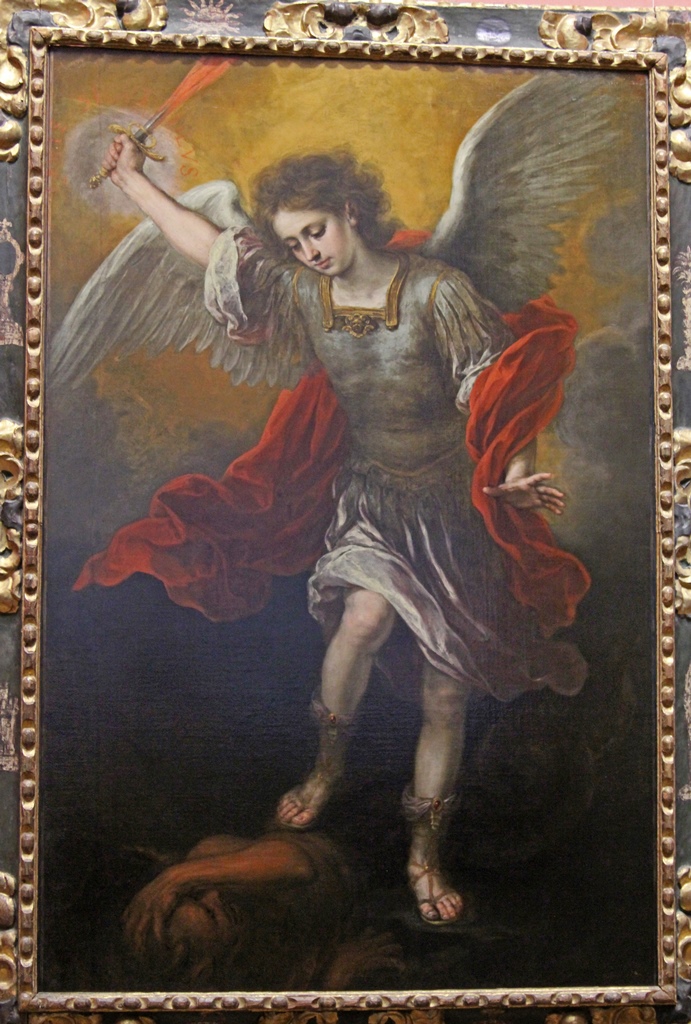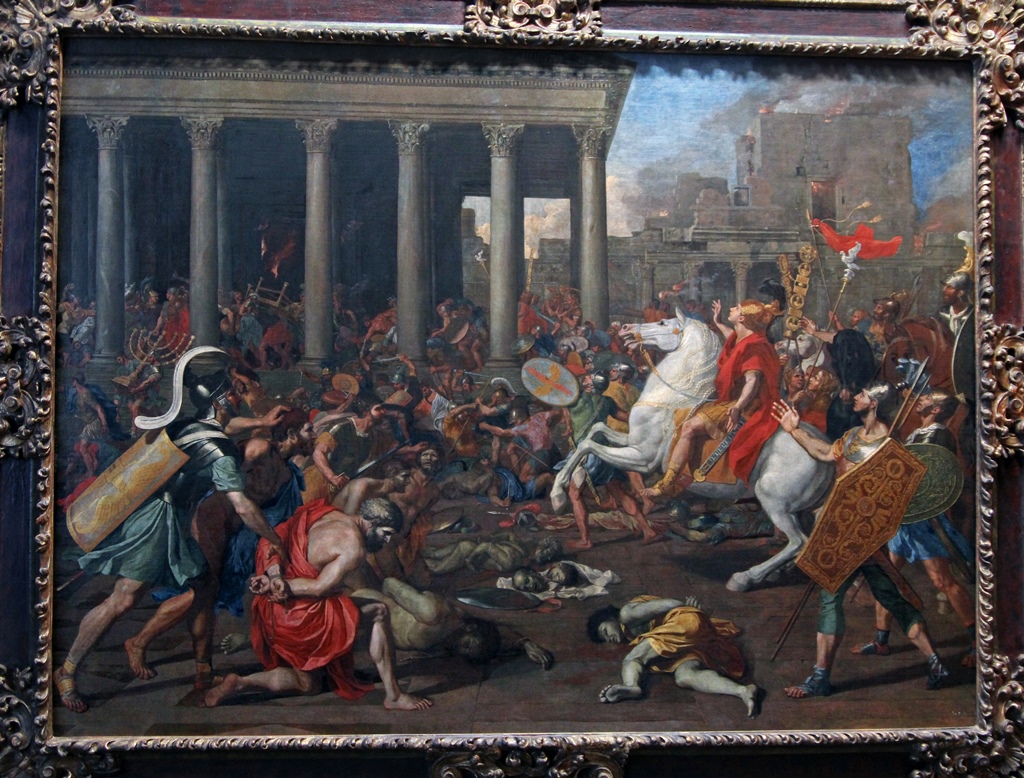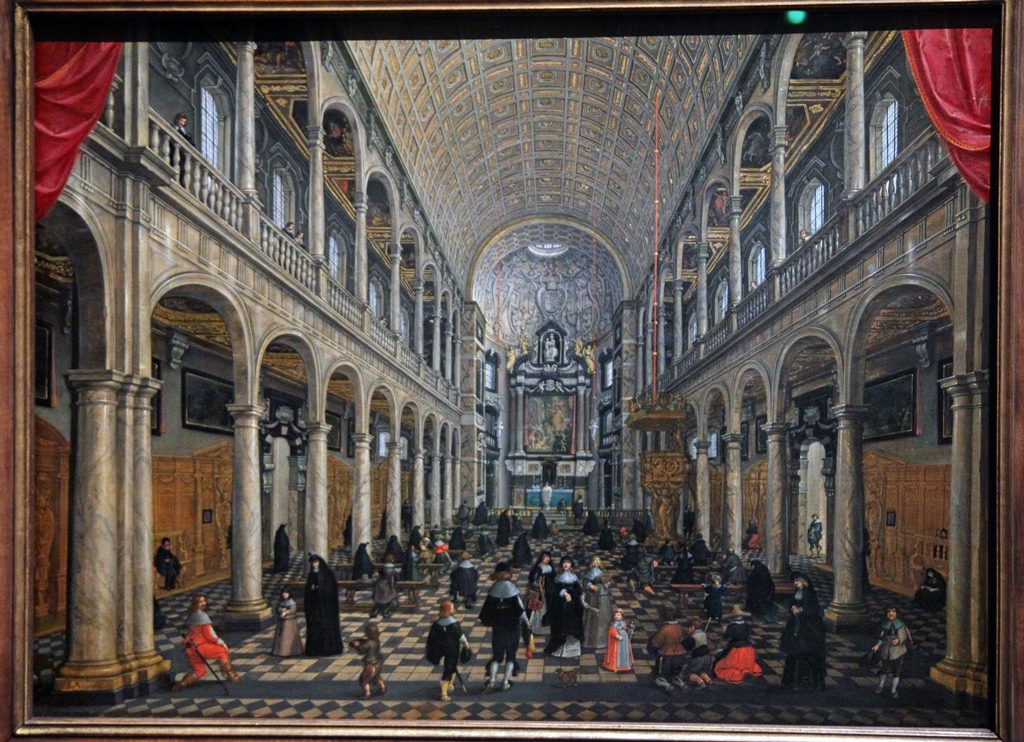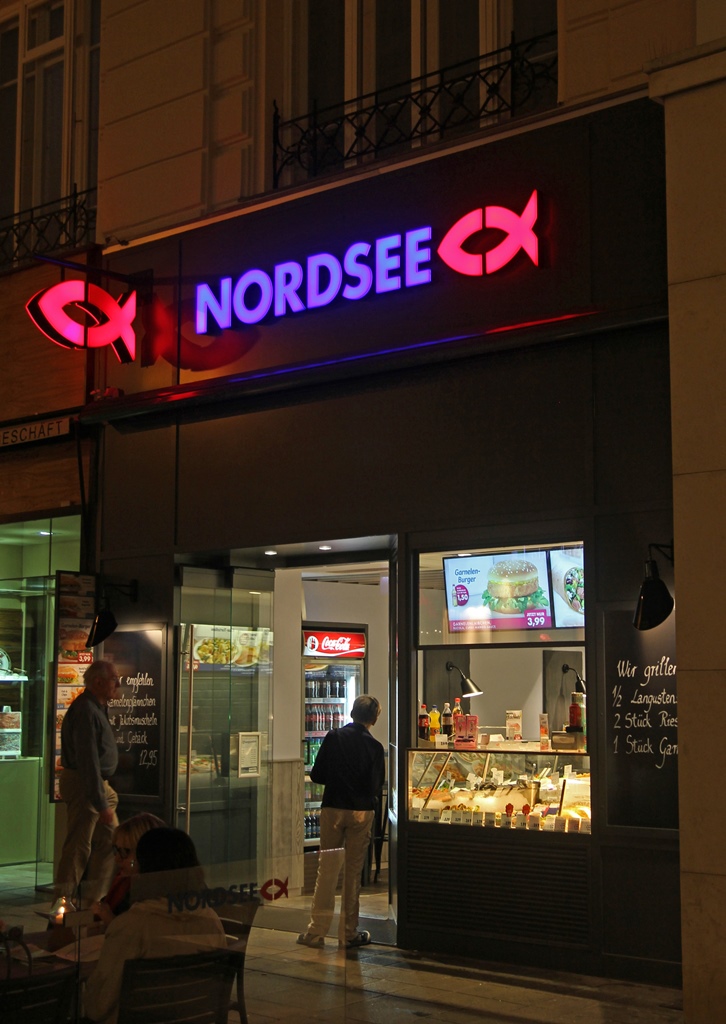Kunsthistorisches Museum
The Kunsthistorisches Museum (or "Art History Museum")
is the largest art museum in Austria, with about 150,000 square feet of gallery space. It
was built between 1871 and 1891 as part of an ambitious plan to create a gigantic
"imperial forum" to the southwest of the already-huge Hofburg palace as it existed in the
mid-19th Century. On the existing palace grounds, two large extensions of the palace
would be built, surrounding a large open space to be called the Heldenplatz
(Heroes' Square). These wings would end just short of the Ringstrasse, but the forum
would continue on the other side of the Ringstrasse (now possible because of the
demolition of the city wall), where two new museums would surround another new square,
called Maria-Theresien Platz, to be devoted to the 18th Century Empress Maria
Theresa. The axis of the Heldenplatz would continue across the Ringstrasse and through
the center of the Maria-Theresien Platz. As it turned out, much of this plan was
completed – the museums were both finished in 1891, and one of the Heldenplatz
extensions (the one on the southeast side of the square) was finished in 1913, and is now
called the Neue Burg (New Castle). The matching palace extension was never built,
so the Heldenplatz is open on one side, where it's adjacent to a large garden area known
as the Volksgarten (Peoples' Garden).
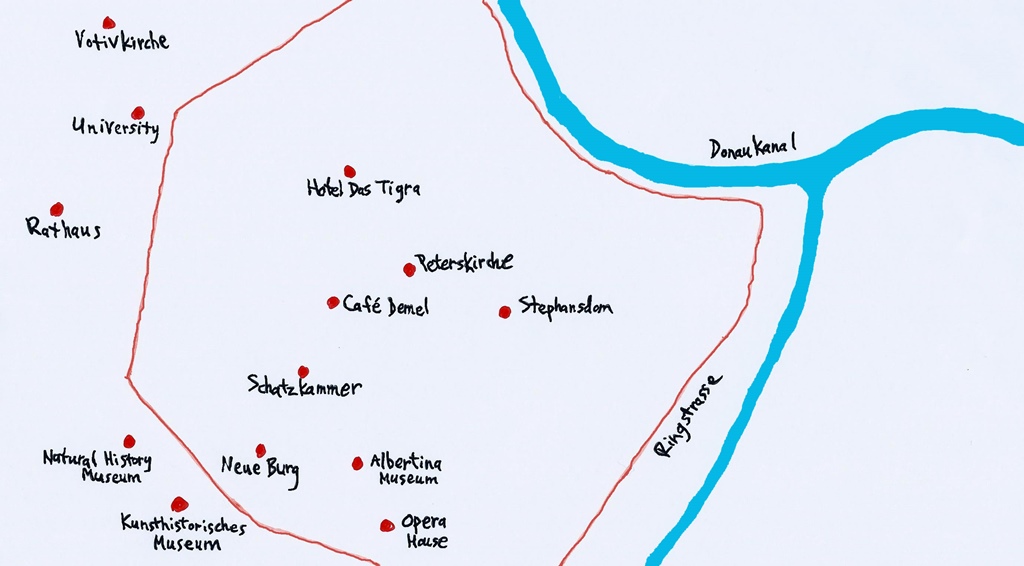
Vienna Old Town
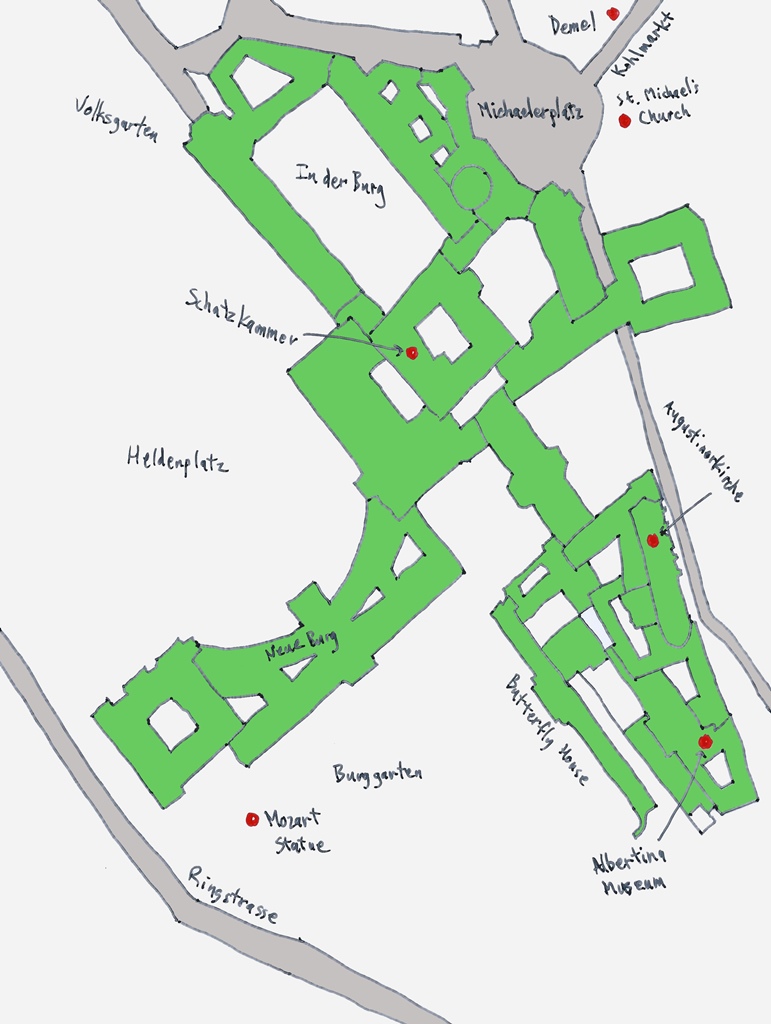
Hofburg, with Neue Burg
Back on the museum side of the Ringstrasse,
the two museums face each other across the Maria-Theresien Platz, looking nearly
identical but serving two very different purposes. One is called the
Naturhistorisches Museum and is devoted to natural history (dinosaur bones,
stuffed animals, astronomical topics, etc.). We have not visited the Naturhistorisches
Museum. But we spent hours inside the other, the Kunsthistorisches Museum.
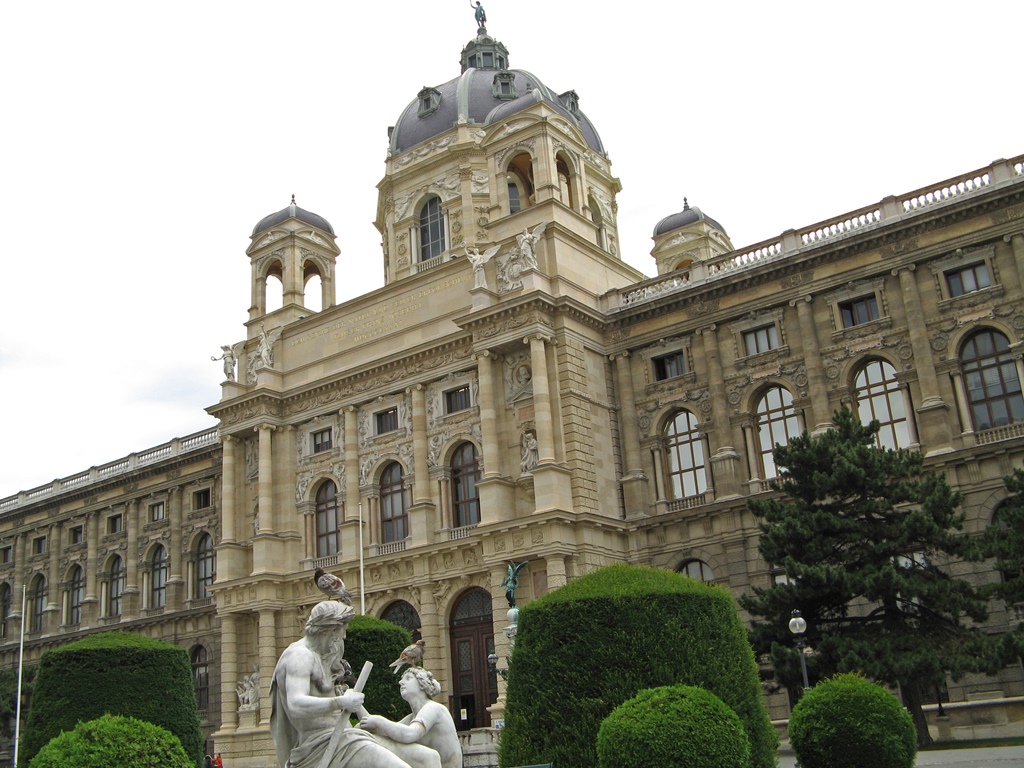
Naturhistorisches Museum
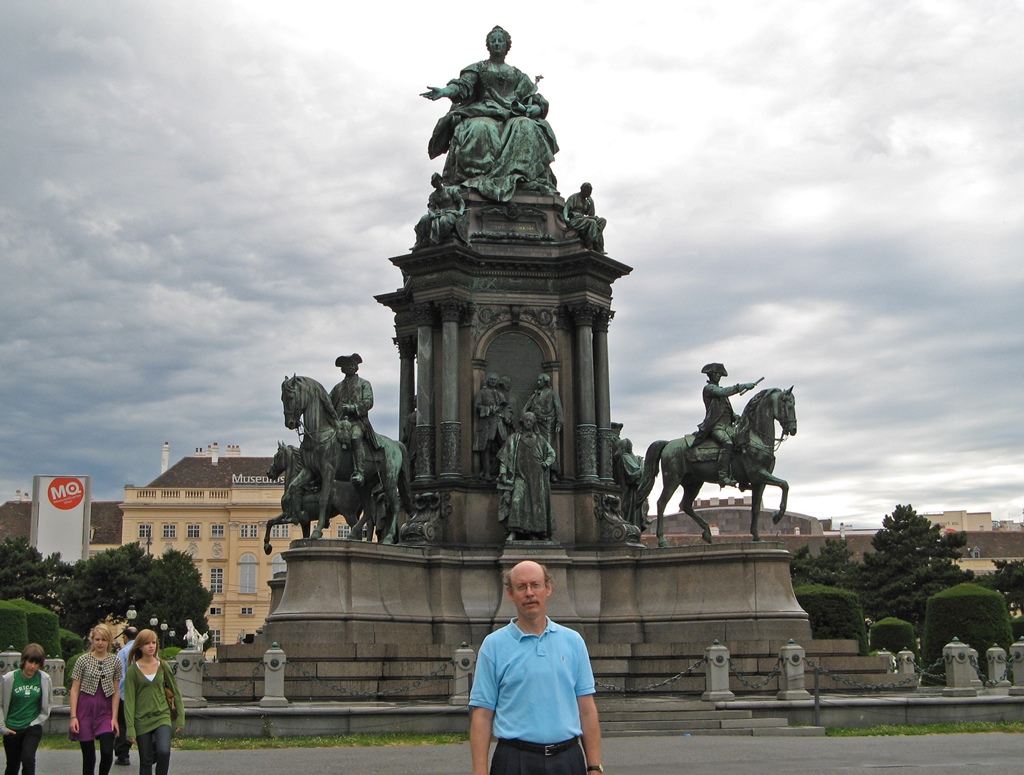
Bob and Maria Theresa Statue
Getting to the Kunsthistorisches Museum from the Albertina Museum was wet but not
complicated – we just headed south toward the Ringstrasse (named Opernring in
the area because of the nearby Opera House) and followed the Ringstrasse clockwise
until the street changed its name to Burgring and we came to the
Maria-Theresien Platz, where the museum buildings were impossible to miss. We paid
our respects to Maria Theresa and then paid for our admission to the building on the
left, and we began our exploration of the Kunsthistorisches Museum with the exhibits
on the ground floor.
First, to the left from the entrance we entered an area called the Kunstkammer,
which consists of 2200 artworks made from valuable or unusual materials. The objects
were generally either gifts to the Habsburg emperors or archdukes, or decorative
objects made by Austria's finest goldsmiths or artisans at the behest of royal family
members (who had sometimes acquired materials from which the objects were made). For the most
part the inventory survived World War II, having been moved from the building to safer
locations (a good thing, as the building suffered significant damage, not being fully
repaired until the early 1960's). Here are some of the artworks of the Kunstkammer,
nearly all originating between the 16th and 18th Centuries:
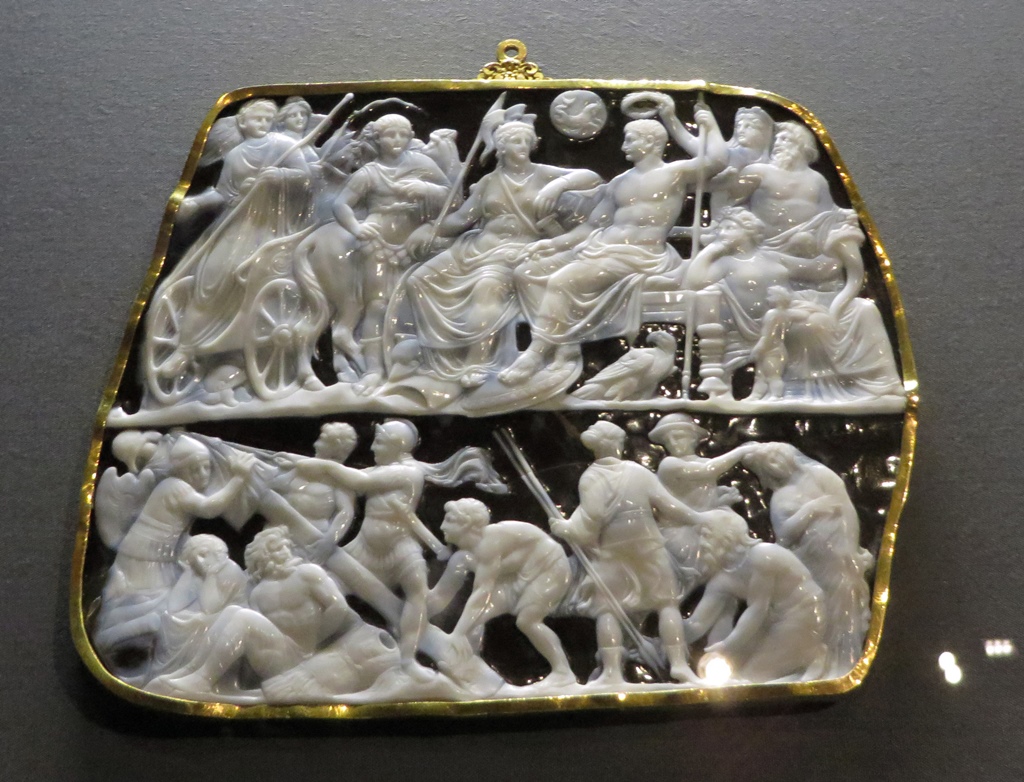
Cameo: Gemma Augustea, Roman (9-12 A.D.)
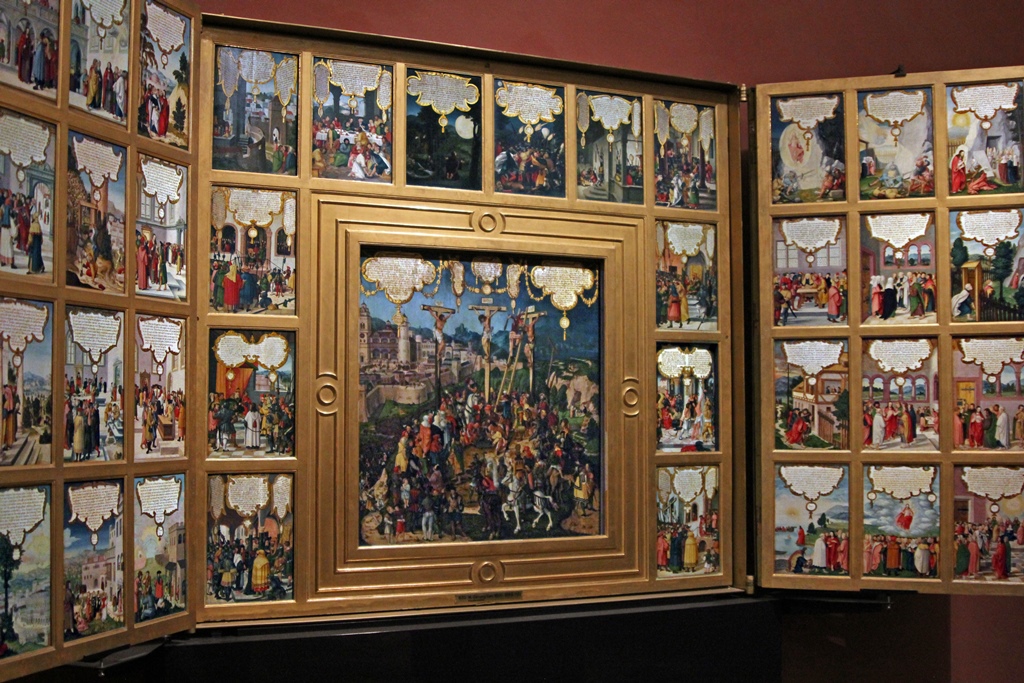
Altarpiece with Scenes from Life of Christ
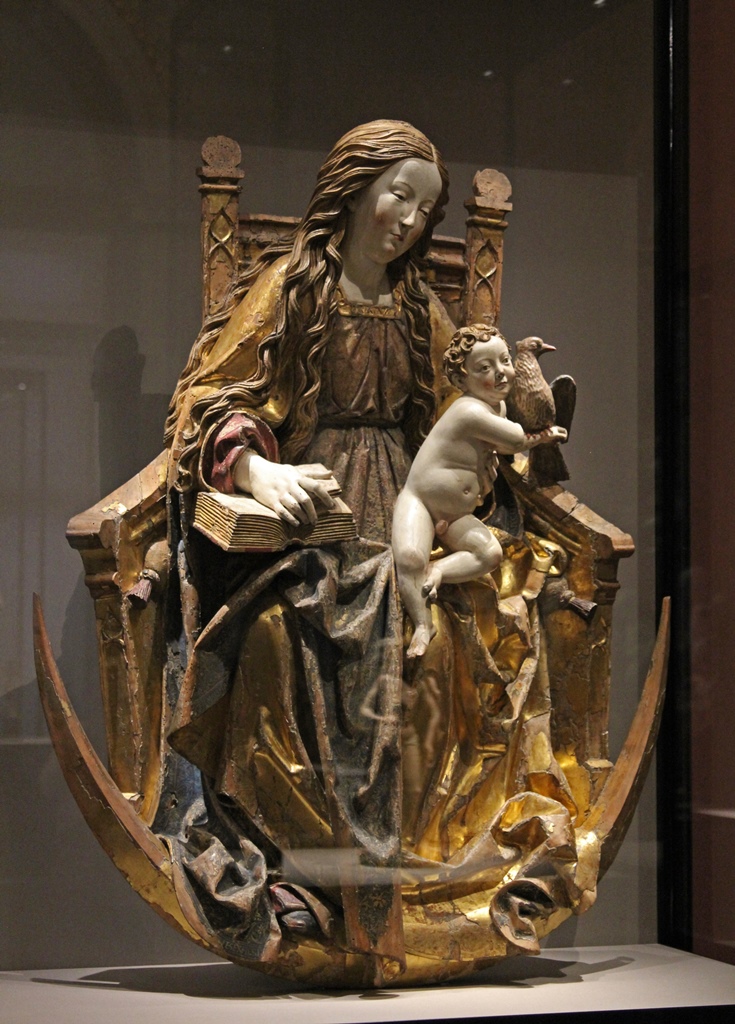
Madonna and Child Enthroned on Crescent Moon, Niklaus Weckmann (ca. 1510-20)
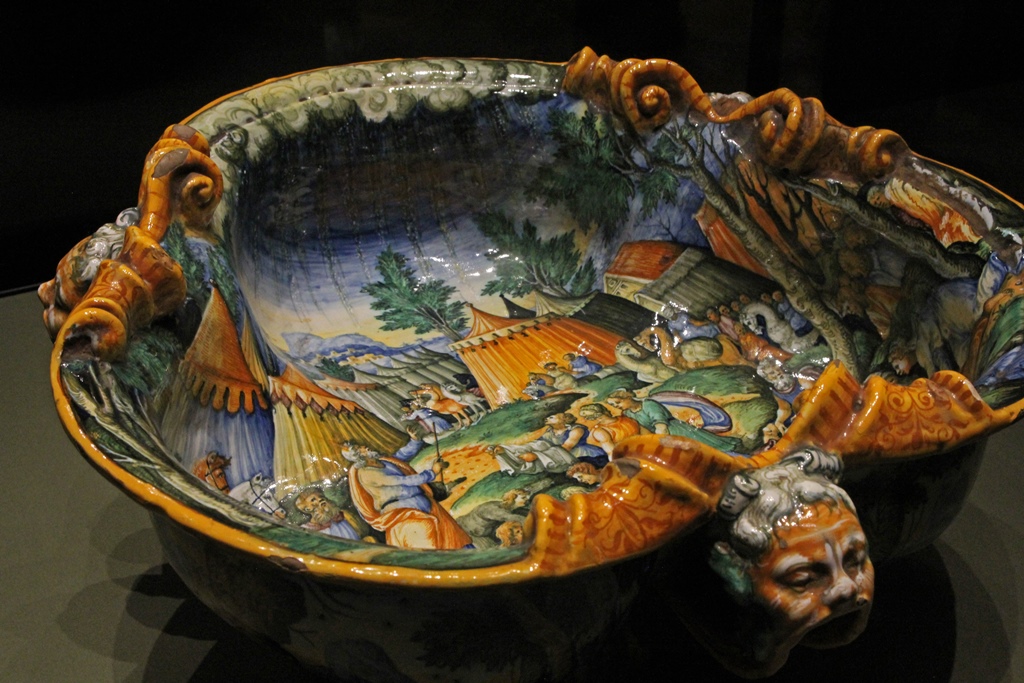
Wine Cooler (ca. 1565)
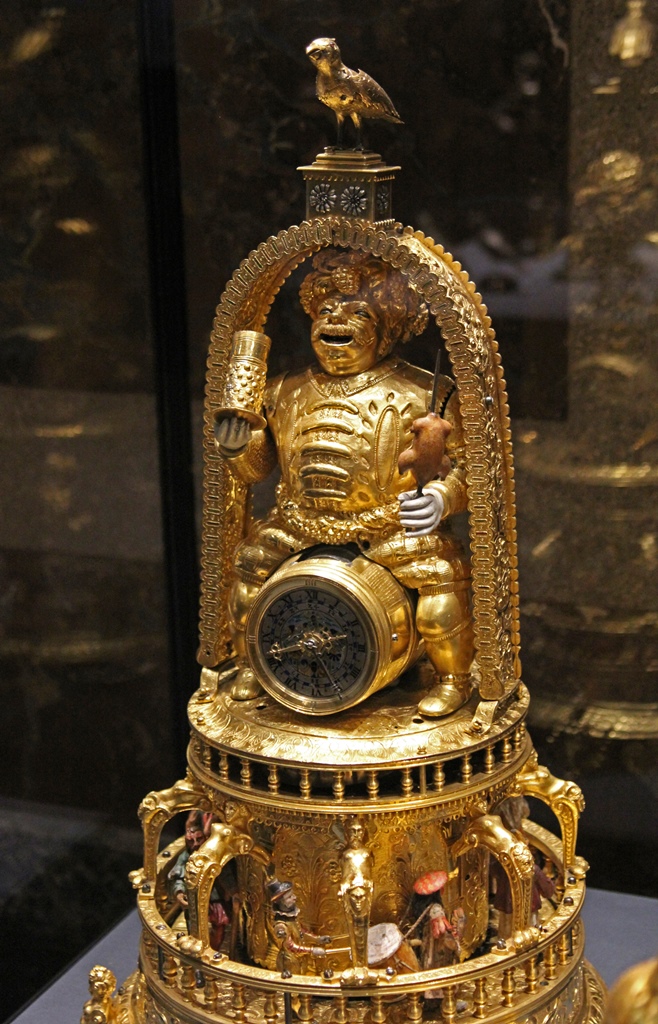
Automated Bacchus Clock (16th C.)
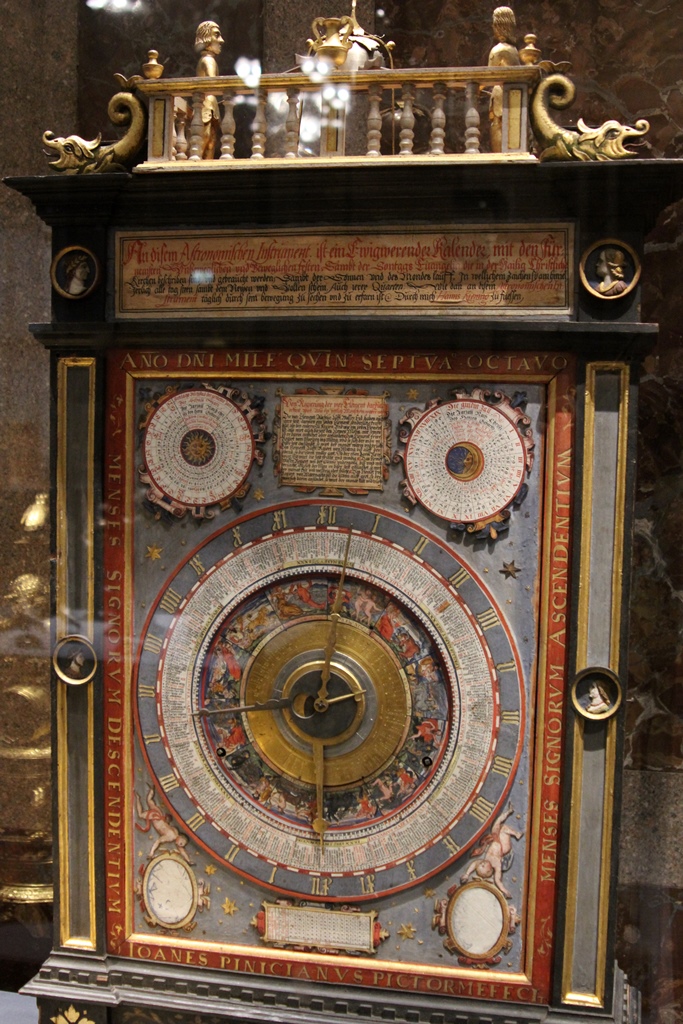
Wooden Case Clock, Hans Kiening (1577-78)
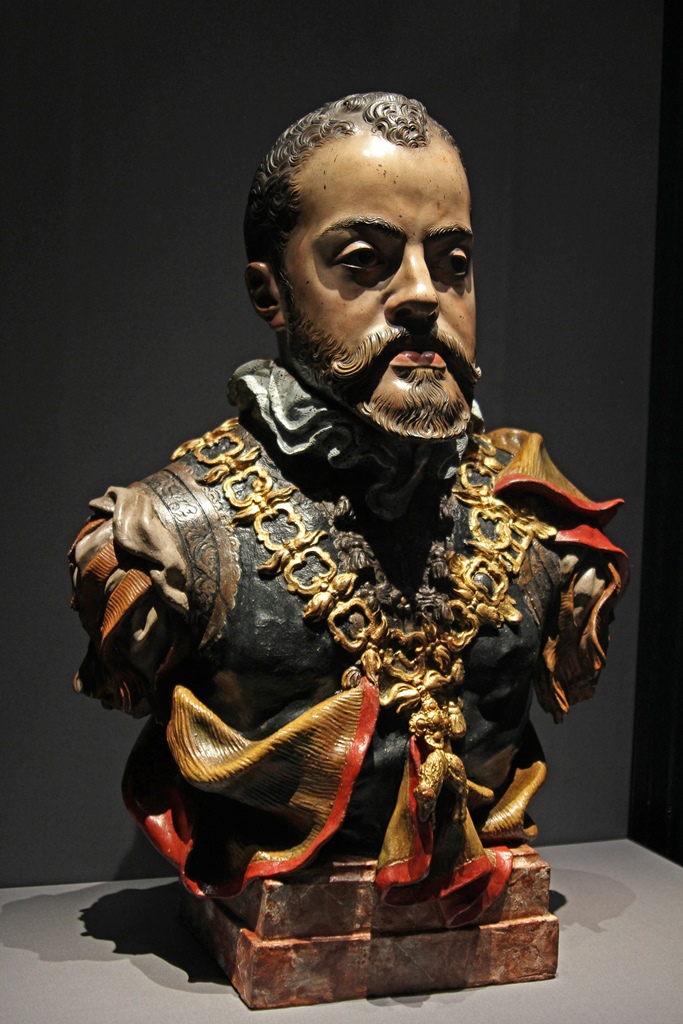
King Philip II of Spain, Pompeo Leoni (ca. 1580)
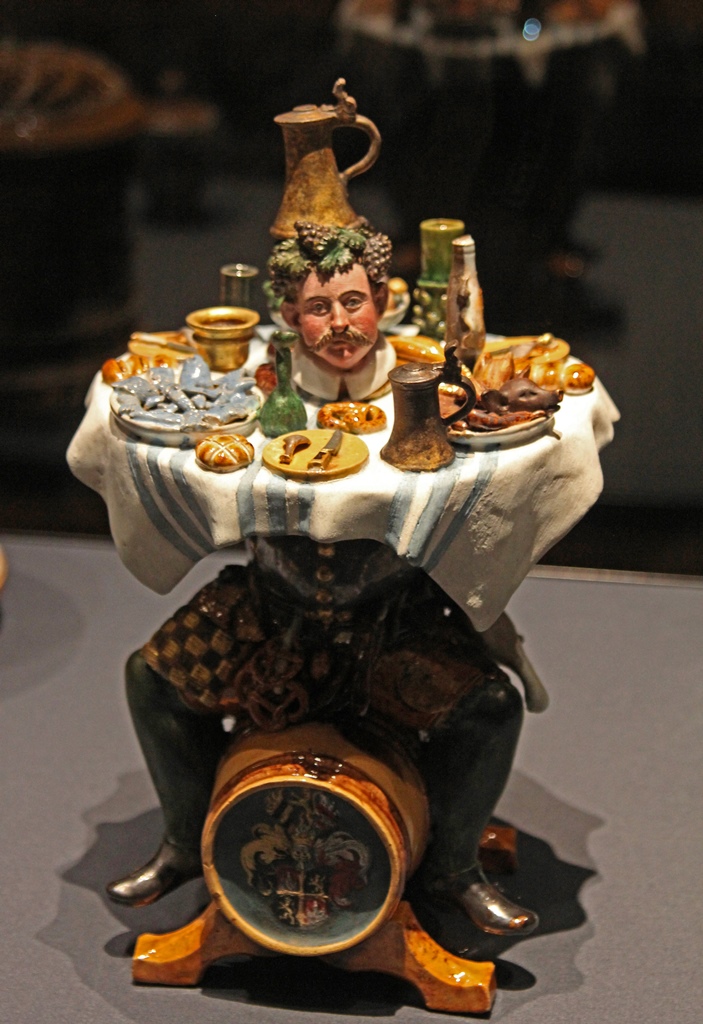
Tantalus as a Joke Box, Christoph Gandtner (ca. 1580-90)
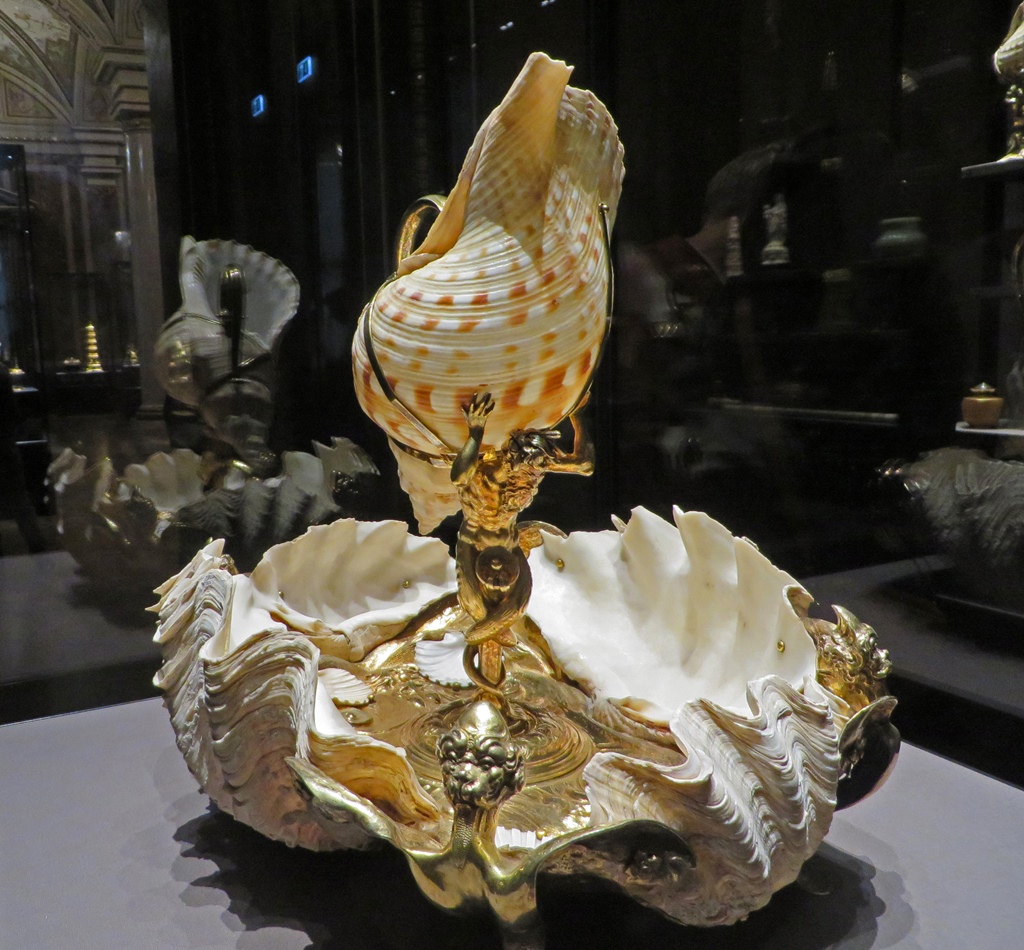
Ornamental Basin with Ewer (ca. 1590-95)
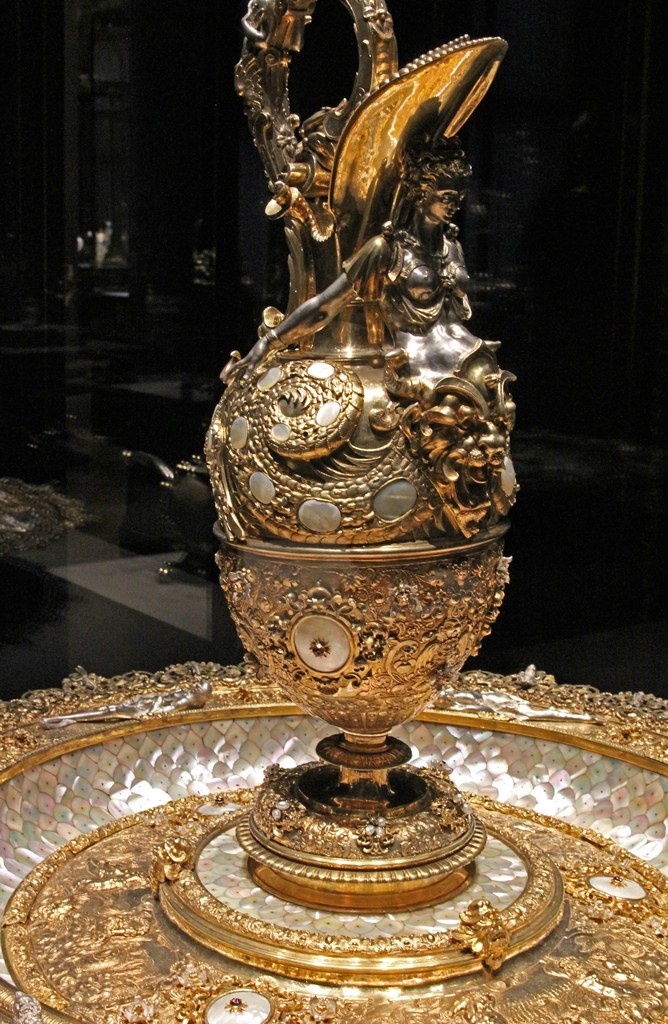
Pitcher from a Washing-Set, Nikolaus Schmidt (ca. 1592)
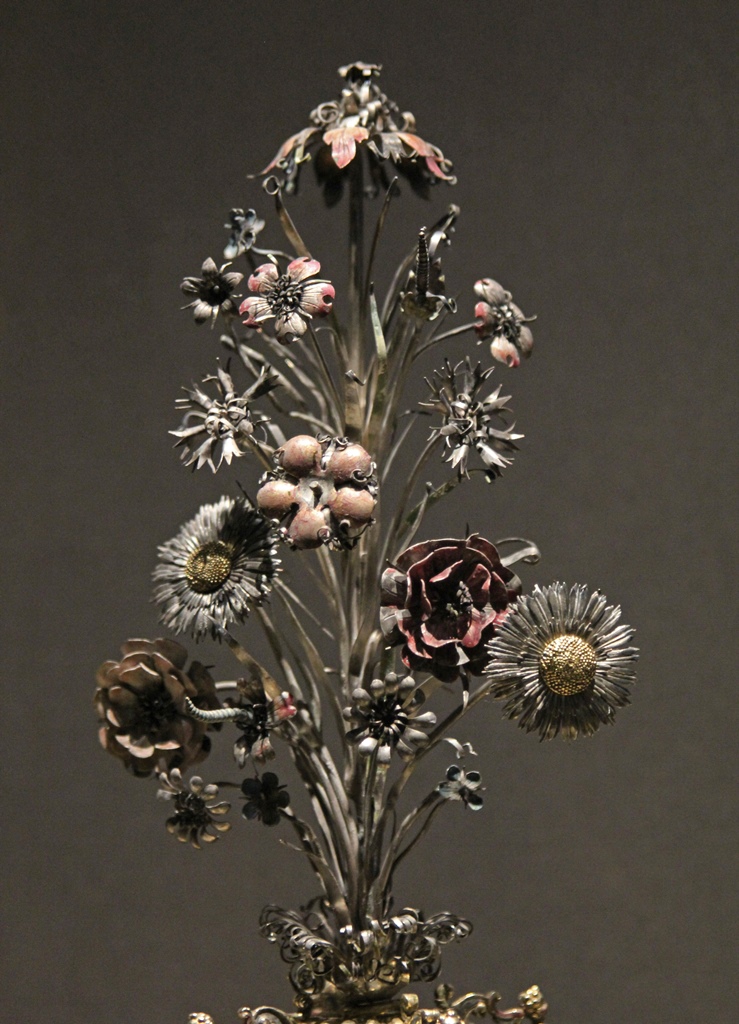
Flowers on Double Cup, Friedrich Hillebrandt (1593-1600)
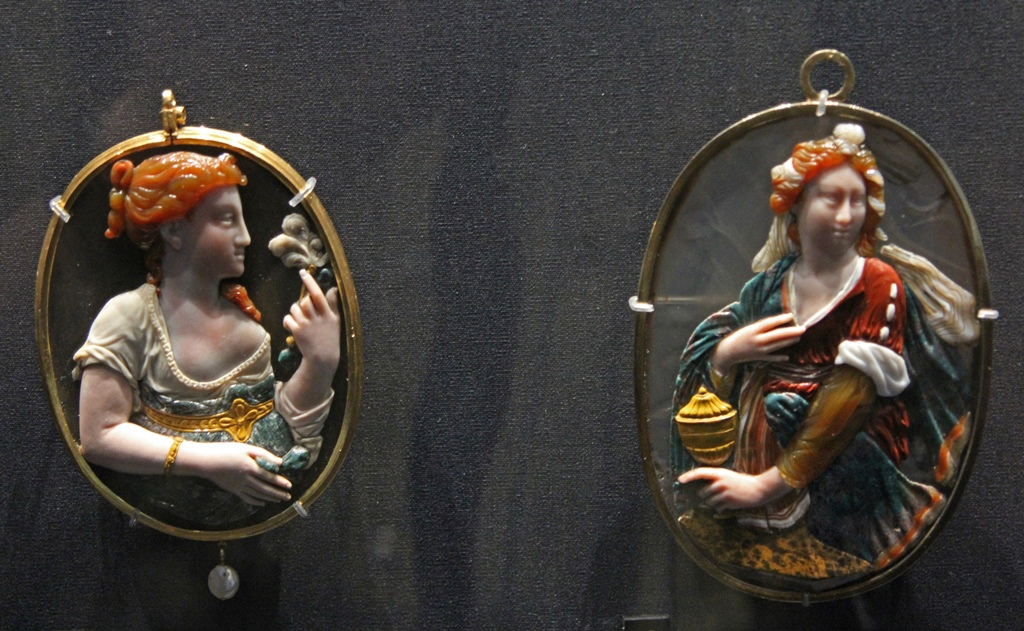
Woman with Fan (ca. 1610) and St. Mary Magdalene (1610), Ottavio Miseroni
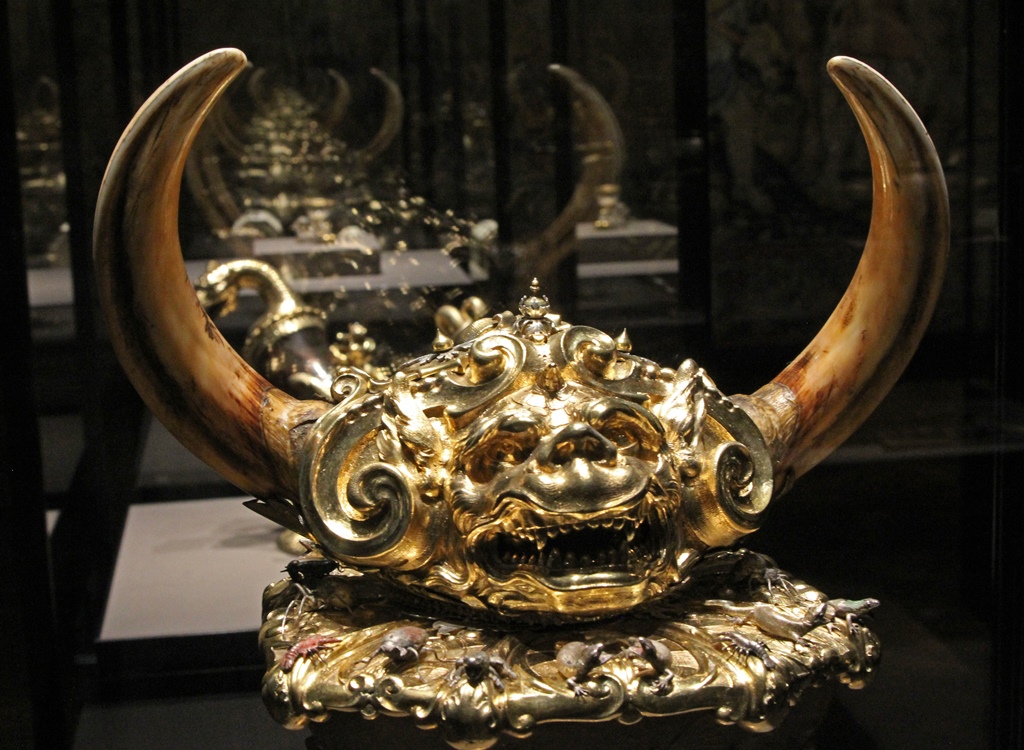
Demonic Cup Cover (1611)
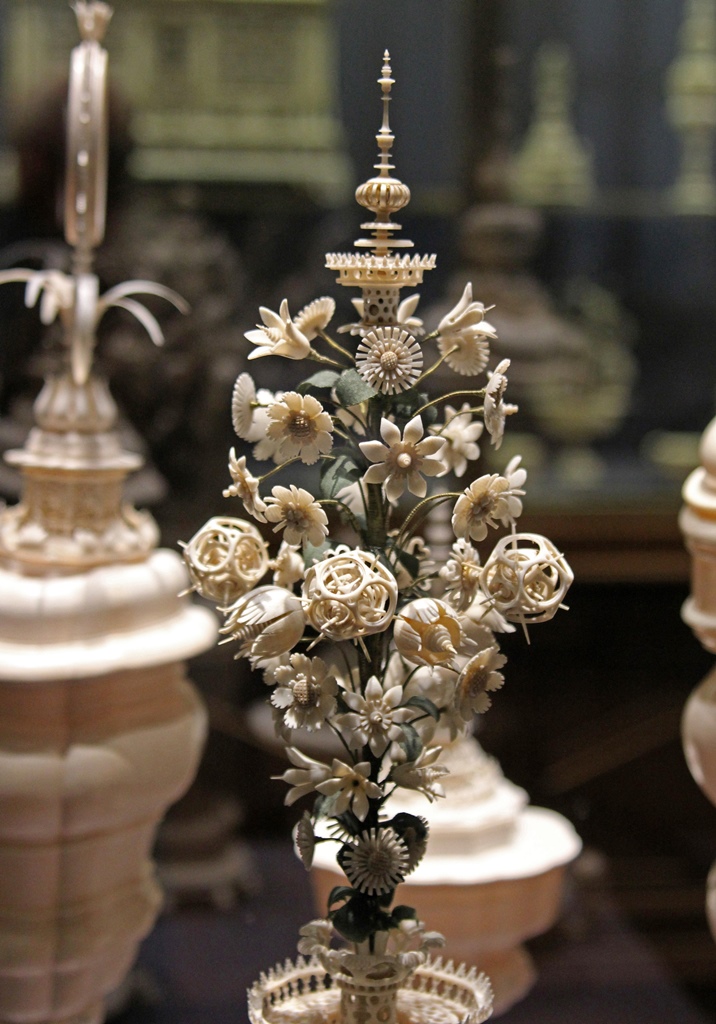
Cup Cover with Flower Bouquet (17th C.)
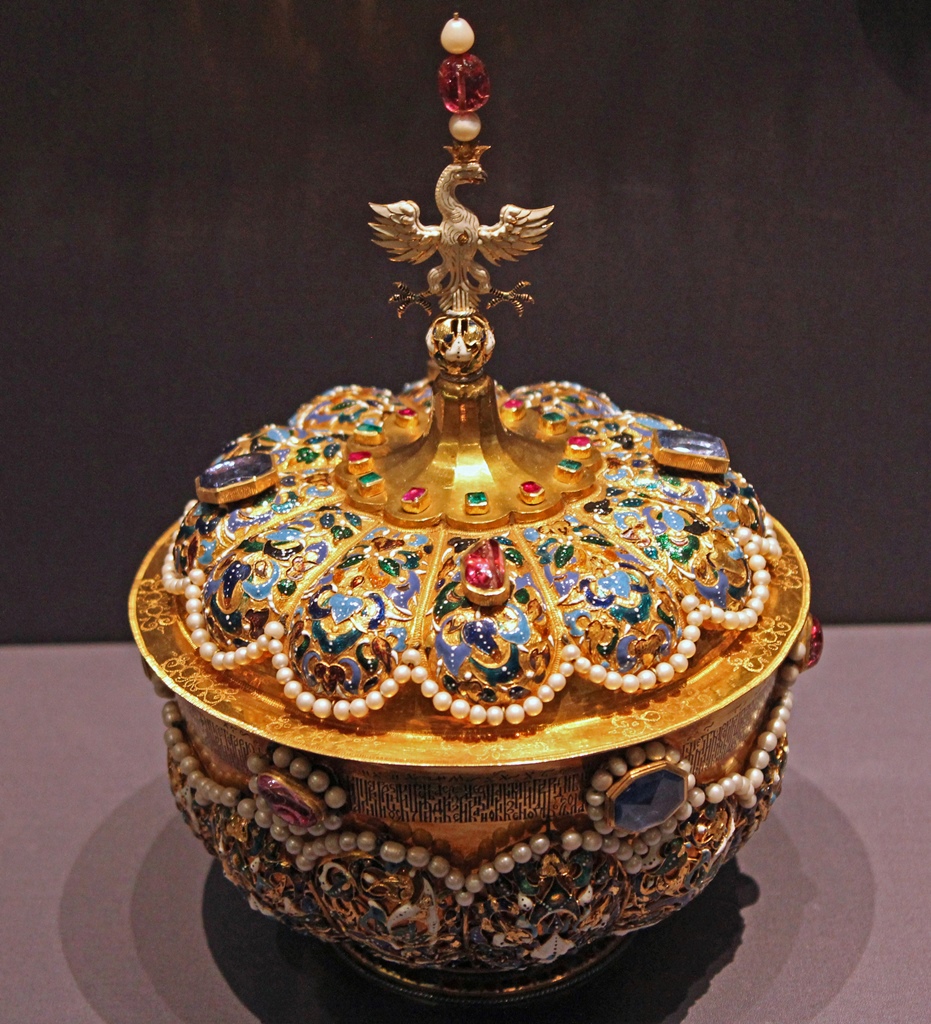
Fraternity Bowl (Bratina) (before 1637)
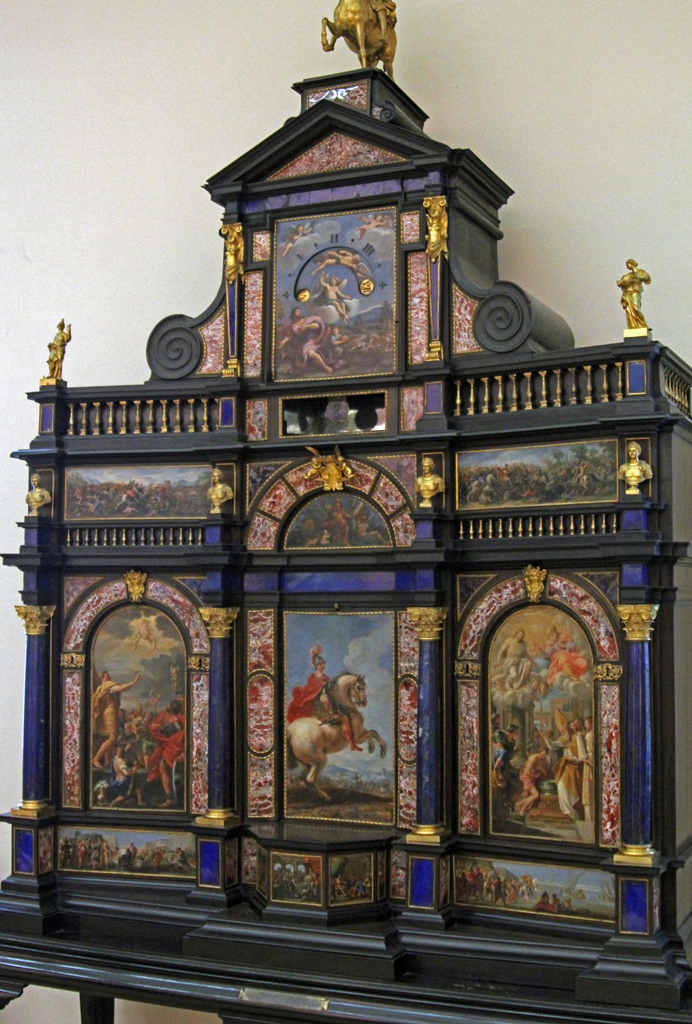
Panelled Cabinet
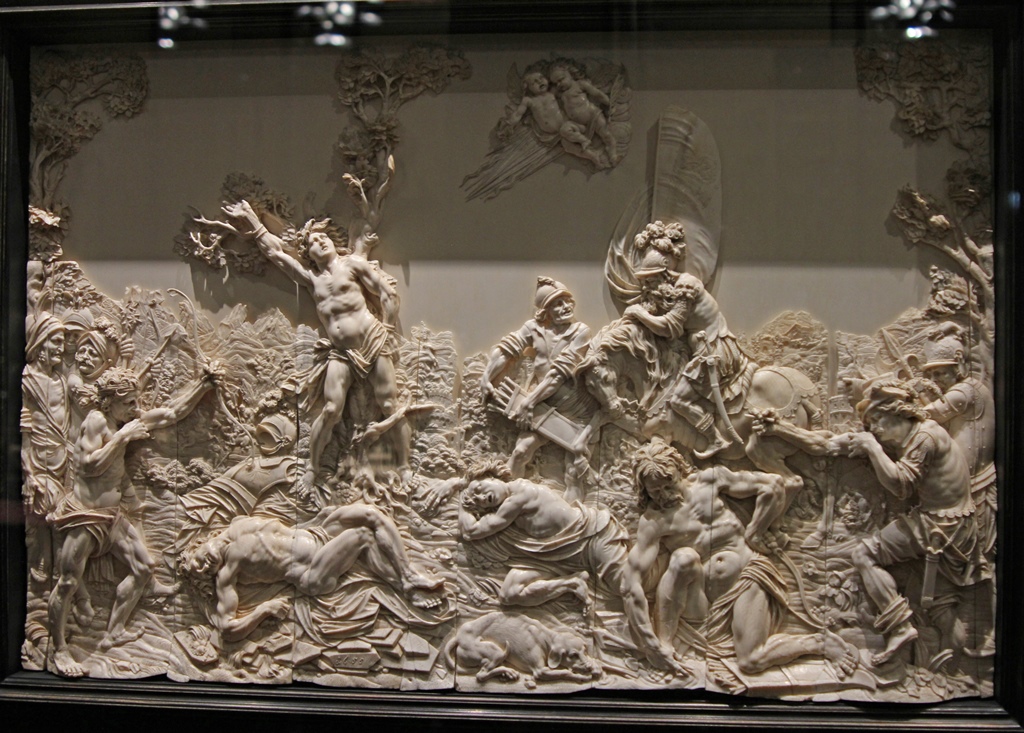
Martyrdom of St. Sebastian (1655)
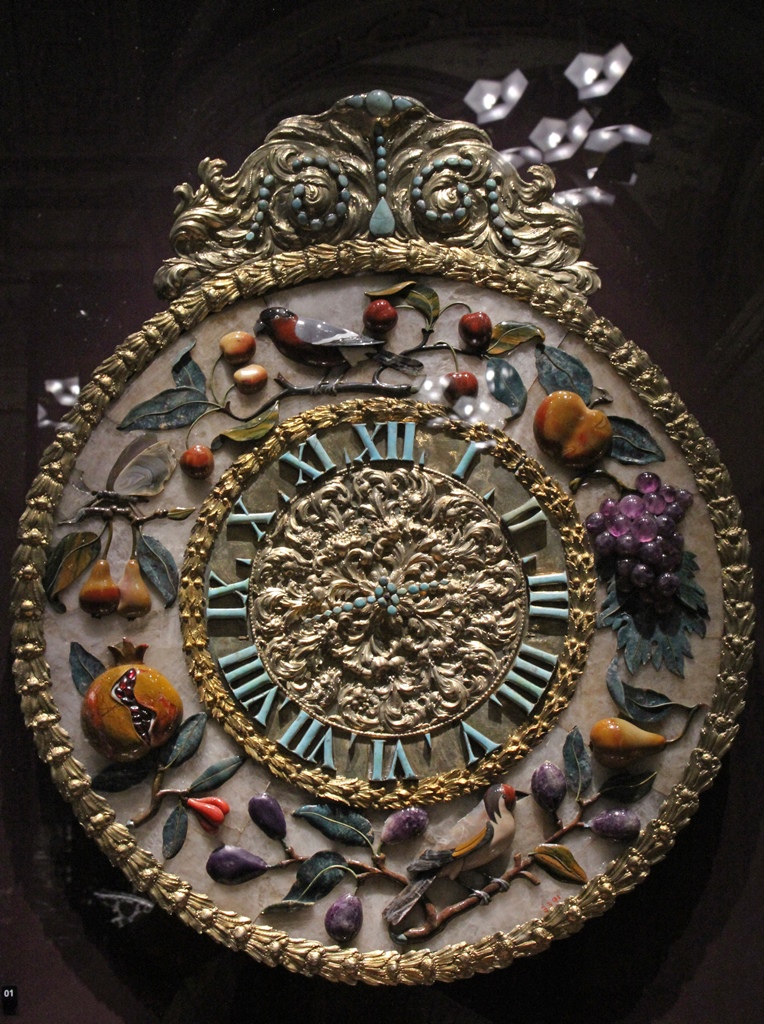
Wall Clock (ca. 1661)
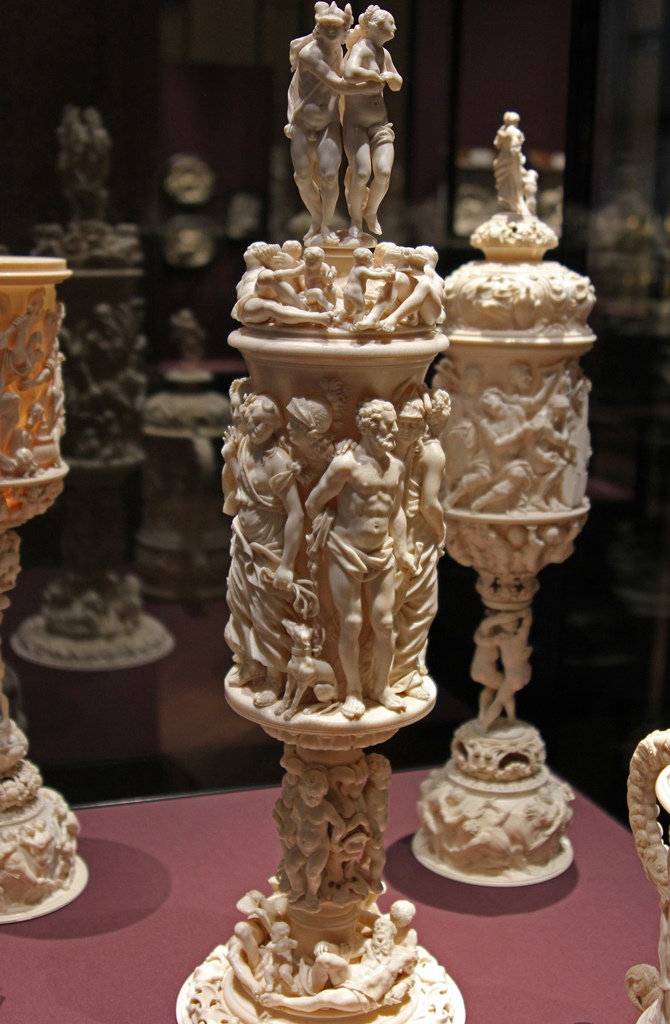
Lidded Cup with Ancient Gods, Bernhard Strauss (ca. 1660-70)
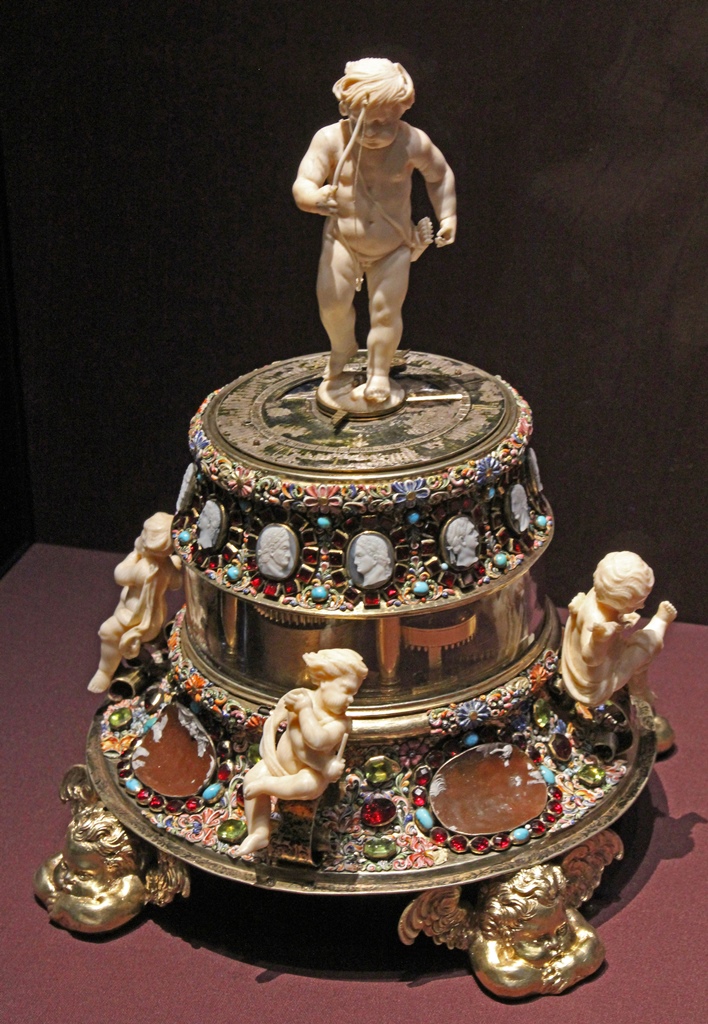
Table Clock with Cupid, Hans Jakob Mair (1665-69)
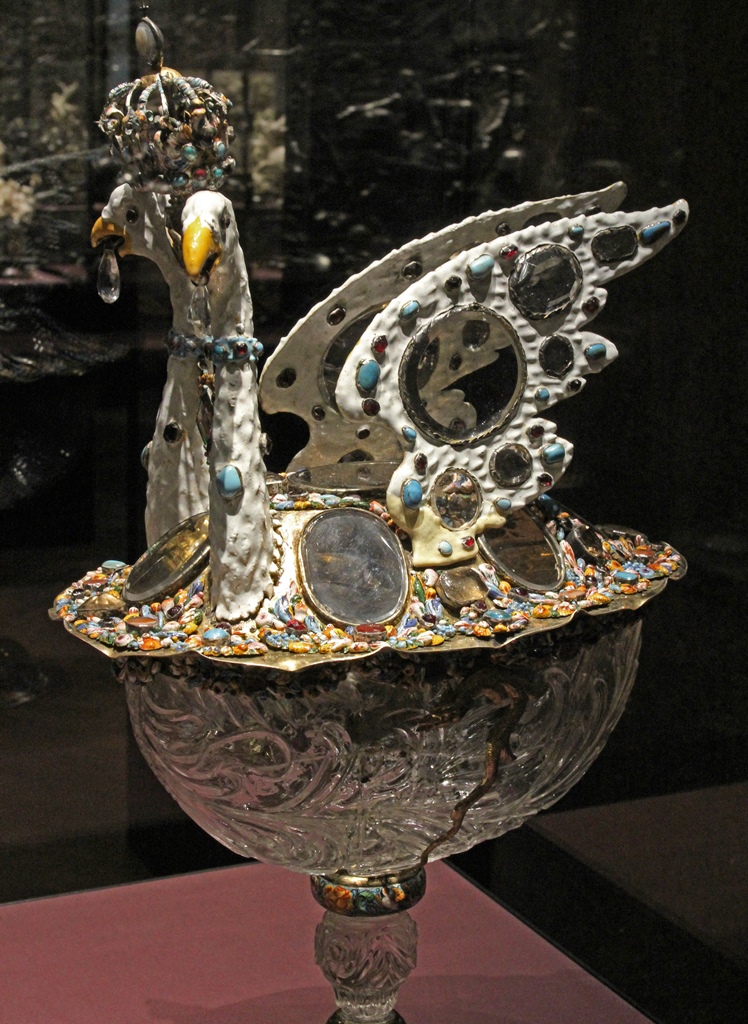
Double-Headed Eagle Centerpiece (ca. 1670-80)
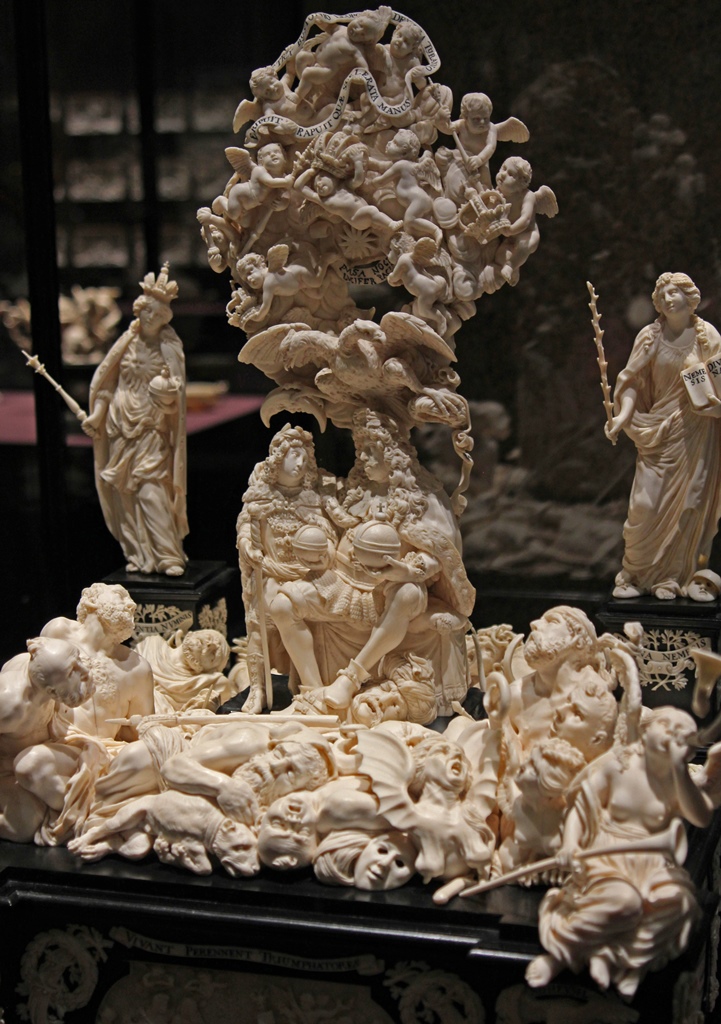
The Triumph of Emperor Leopold I, Christoph Maucher (1700)
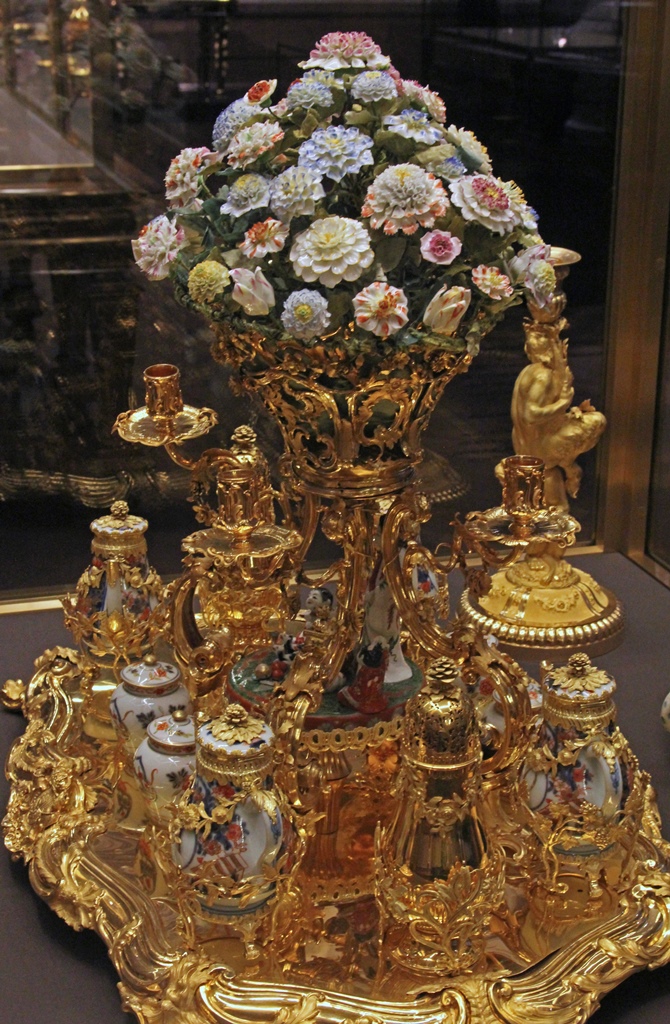
Gold/Porcelain Tea Set, Pieter Jozef Fonson (1755)
One particular work in the Kunstkammer is especially valuable. It's known
as the Saliera, completed by Italian artist Benvenuto Cellini in 1543. It's
made of ivory, gold and enamel and was designed to hold salt and pepper. It's
the only known surviving work of precious metal by Cellini. The two figures
depicted on the Saliera represent the sea (the male figure) and the earth (the
female figure). The Saliera was created for Francis I of France, but was given
as a gift later in the 16th Century to Habsburg Archduke Ferdinand II by French
King Charles IX. It was one of the early works put on display after the
Kunsthistorisches Museum opened, but became best known in 2003, when it was
stolen from the museum during a renovation, at the time representing the biggest
art theft in Austrian history. It was recovered in 2006, when it was found
buried in a lead box in a forest north of Vienna (the thief had turned himself
in after being identified from surveillance photos). At present the Saliera is
insured for about $60 million.
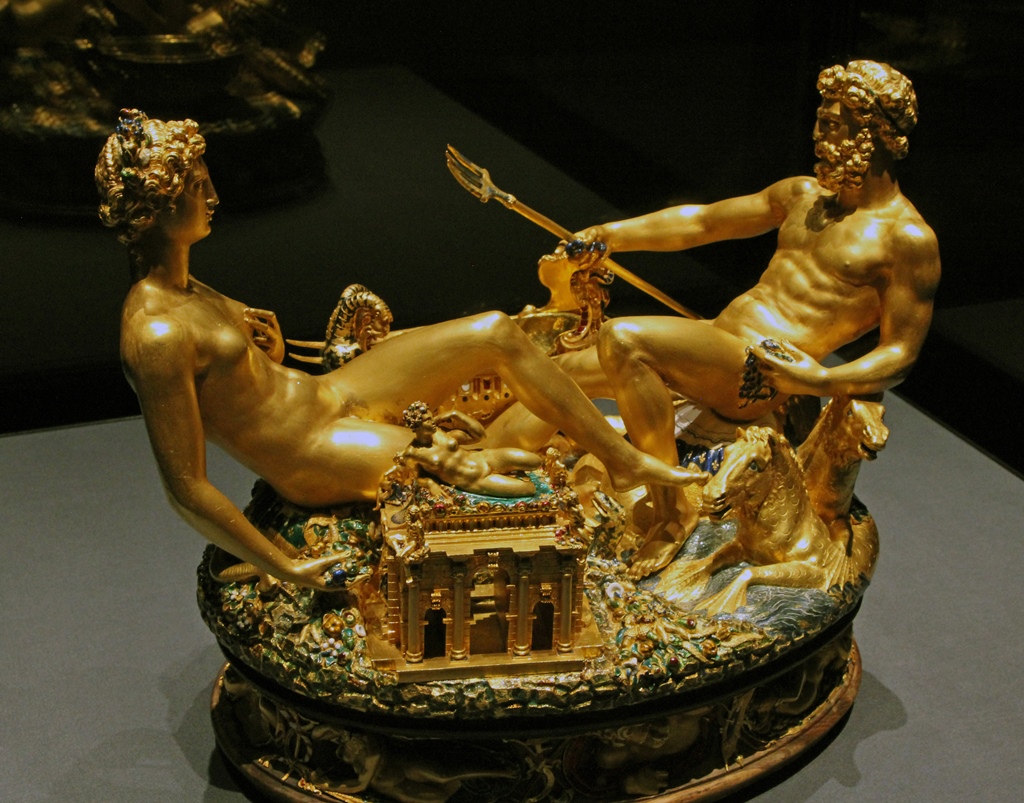
Saliera, Benvenuto Cellini (1540-43)
Across the lobby from the Kunstkammer, on the other side of the entrance, is the
entrance to the museum's Egyptian and Near Eastern Collection, where we headed
next. The collection is immense, with more than 17,000 objects dating back from
3500 B.C. through the early Christian era (only a fraction are on display). While
the Habsburgs' acquisition of ancient Egyptian artifacts began as early as the
16th Century, this was not one of their priorities. People in general were not
very interested in ancient Egypt until 1798-99, when Napoleon's invasion of the
country brought international attention to the region. Avid interest in ancient
Egypt and collection of its artifacts by seemingly everybody began in earnest in
the 19th Century. Gifts from many sources (including the Egyptian government)
flooded into Vienna, while members of the royal family (especially including
Franz Joseph's son, Crown Prince Rudolph) were completing acquisitions of their
own. All of this stuff ended up with the Kunsthistorisches Museum when it
opened in 1891.
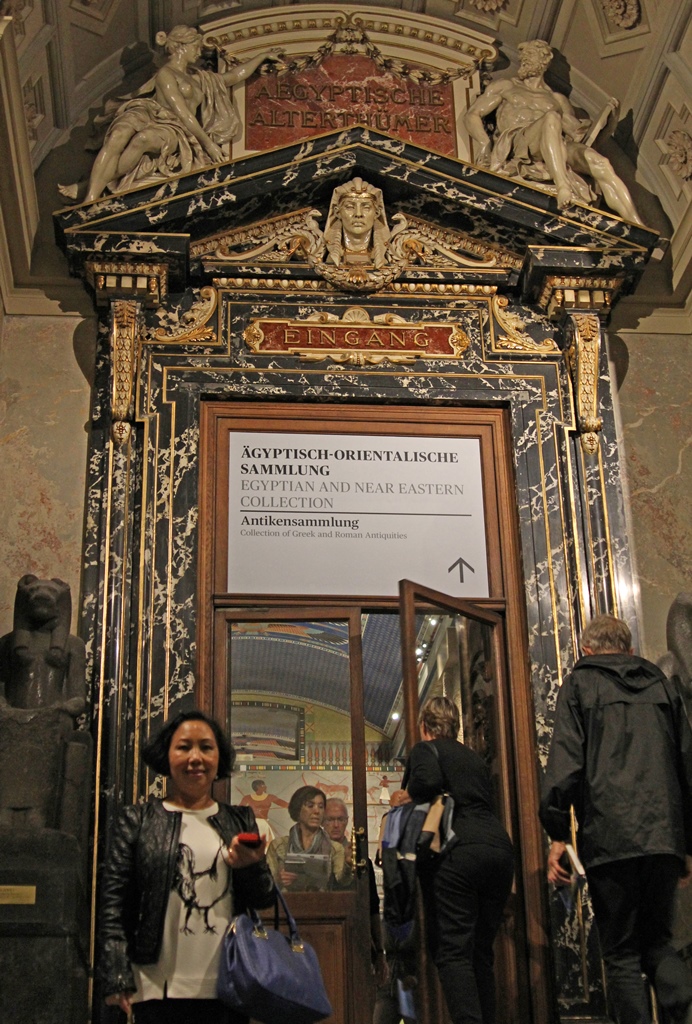
Nella and Entrance to Egyptian and Near Eastern Collection
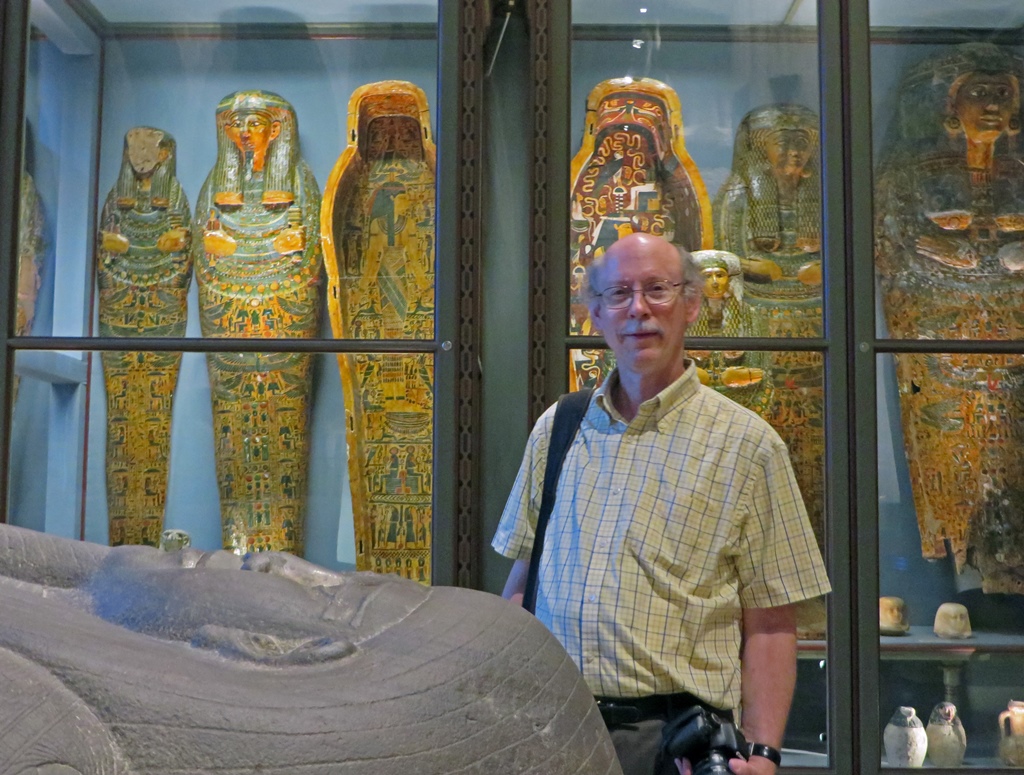
Bob and Sarcophagi
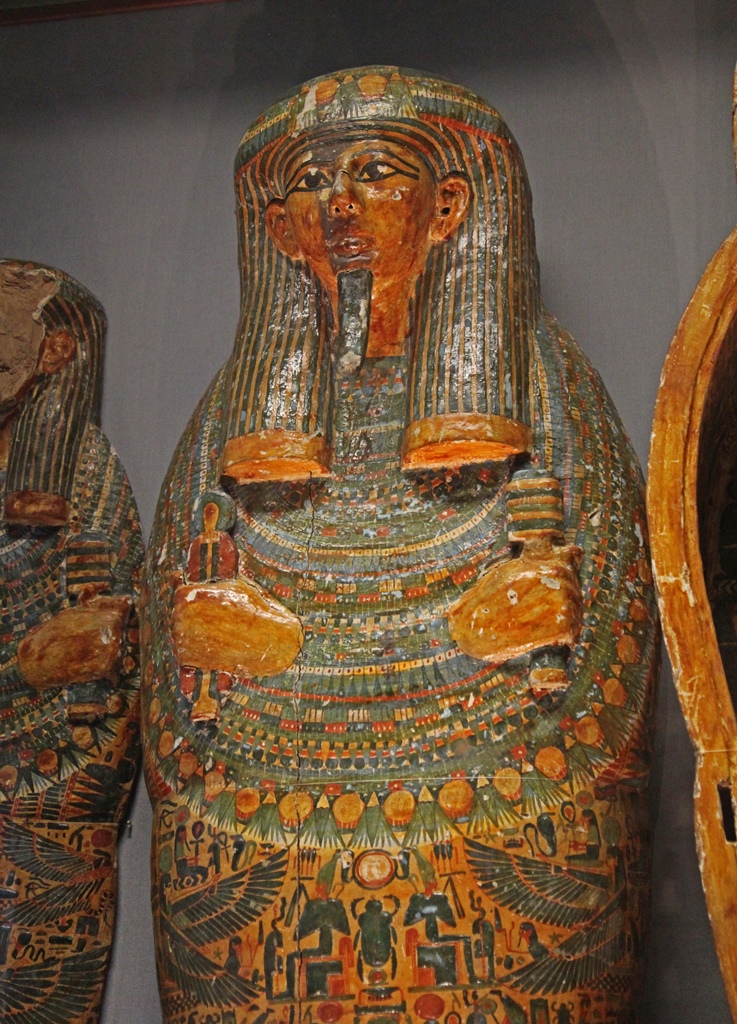
Coffin of Nes-pauti-taui (21st Dynasty, before 969 B.C.)
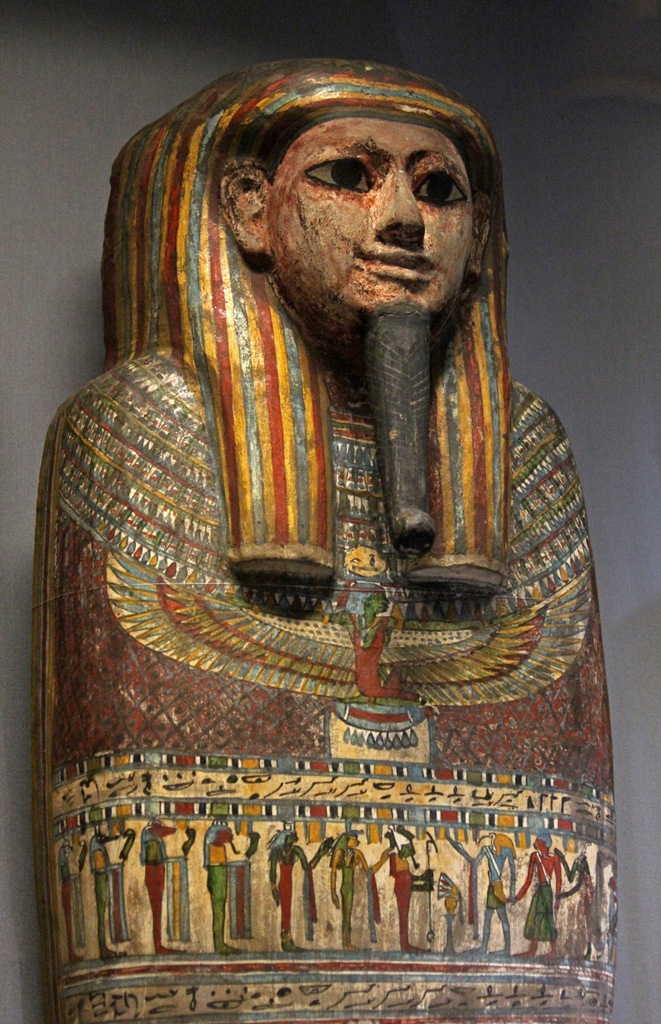
Coffin of Hetep-imen (25th-26th Dynasty, ca. 8th-6th C. B.C.)
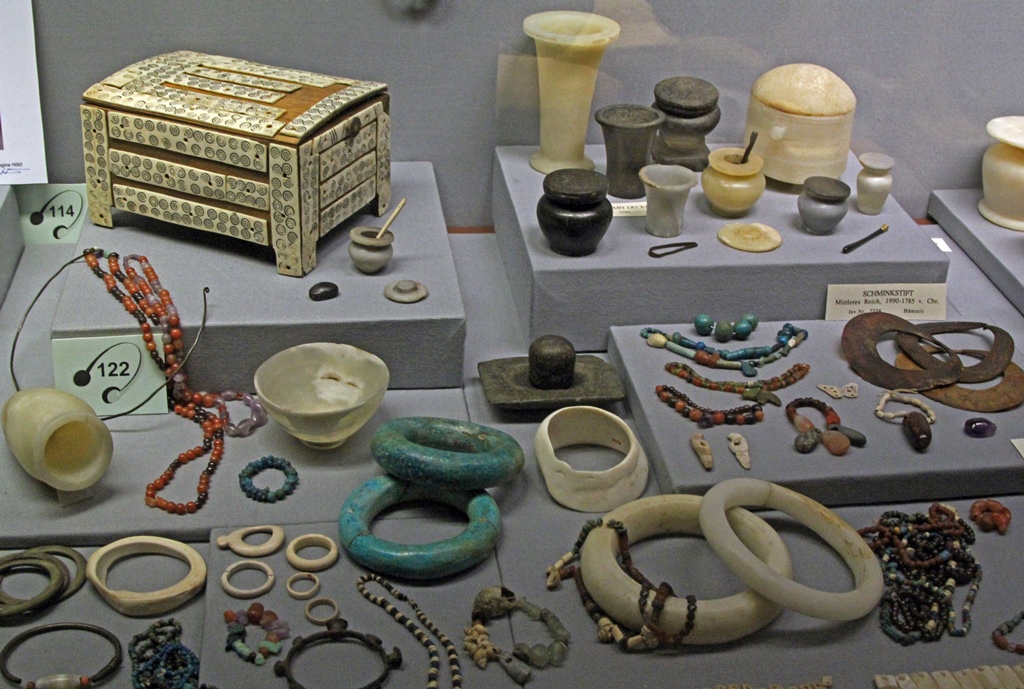
Egyptian Tomb Items
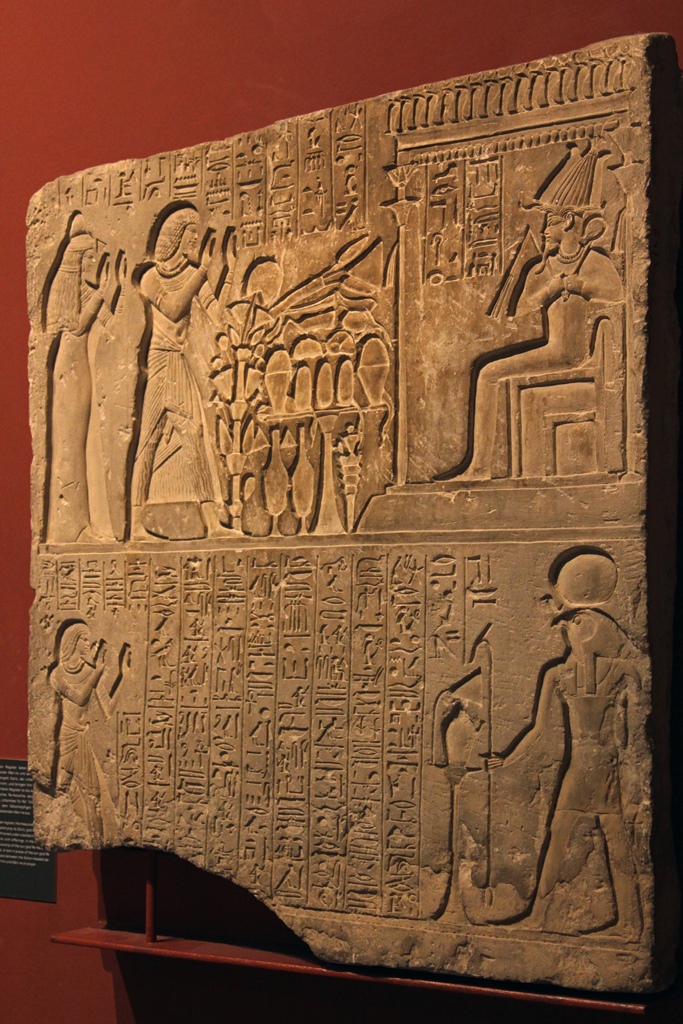
Relief from the Tomb of Meri-re (18th Dynasty, 1410-1372 B.C.)
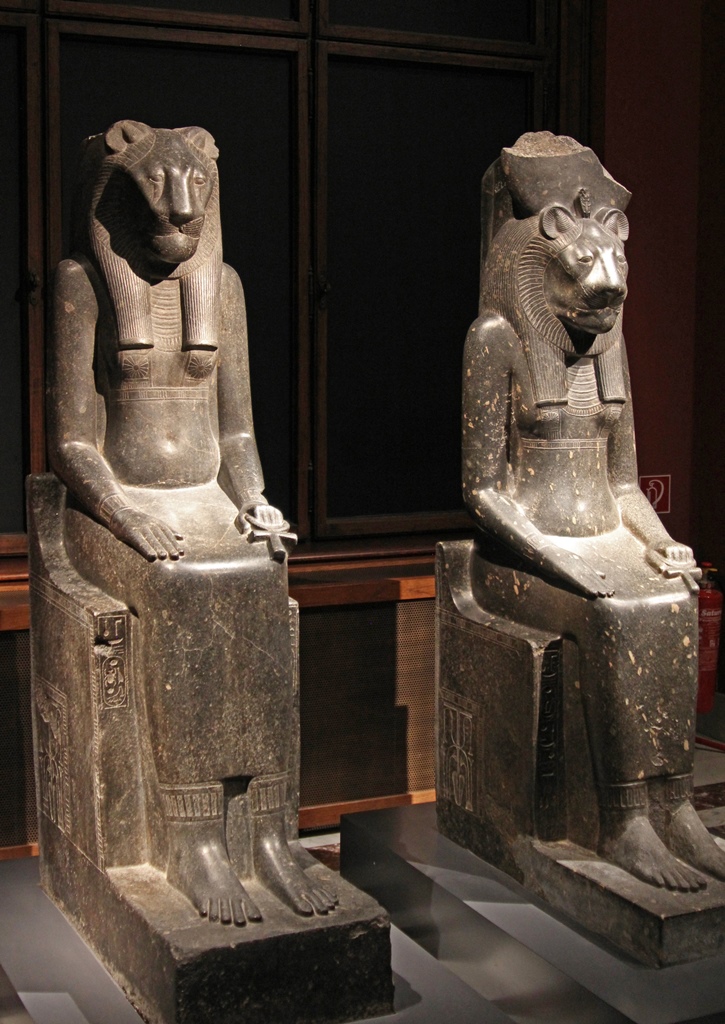
Statues of Goddess Sakhmet (18th Dynasty, 1410-1372 B.C.)
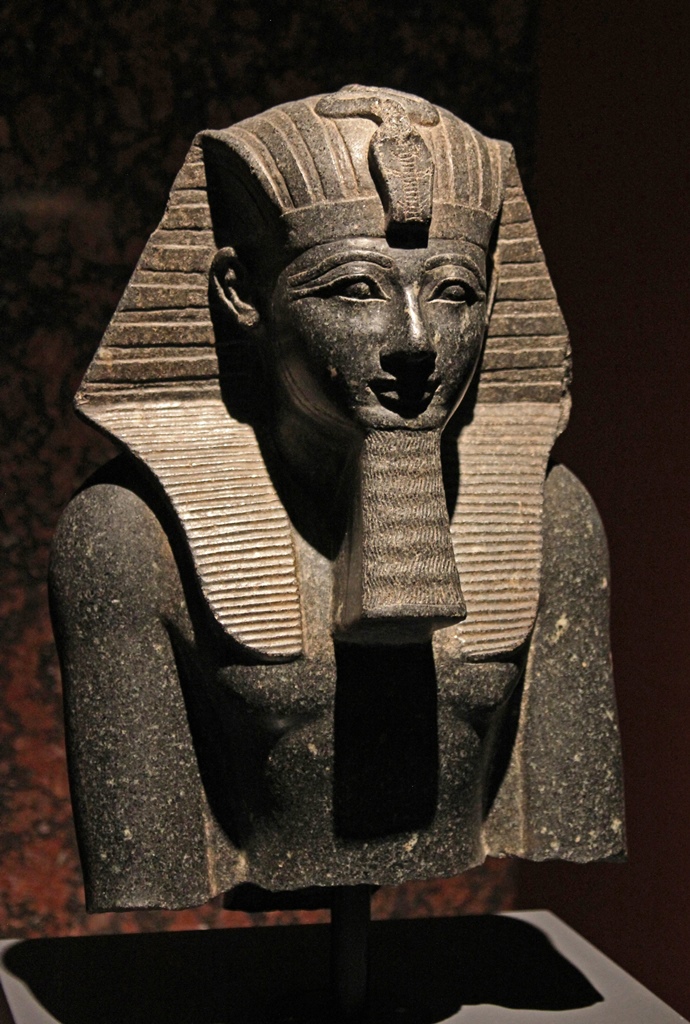
Statue of Thutmose III (18th Dynasty, 1504-1452 B.C.)
Passing through the Egyptian and Near Eastern exhibits, we started running into
things that looked Greek and Roman. This is because we had entered the Collection
of Greek and Roman Antiquities. The rooms of this exhibit have about 2500 items
on display, which represents a small fraction of the items in the collection. As
with the Egyptian artifacts, interest in Greek and Roman stuff exploded in the
19th Century, and artifacts were acquired at a rapid clip, as gifts, through
purposeful (and pricey) acquisition, and through (also pricey) archaeological
expeditions. The items accumulated in the Augustinian Corridor of the Hofburg
palace until some of them needed to be moved somewhere else, and in 1845
sculptures and inscribed stones were moved to the lower Belvedere Palace, outside
the Old Town area. In 1891, many artifacts found a home in the new
Kunsthistorisches Museum, but there was much that wouldn't fit. In 1978 a new
museum was opened in the Neue Burg for the display of artifacts found in the
excavation of the ancient city of Ephesus (in modern-day Turkey), but many
artifacts to this day are still looking for a permanent home. Here's some of
what we found in the Kunsthistorisches Museum's Collection of Greek and Roman
Antiquities:
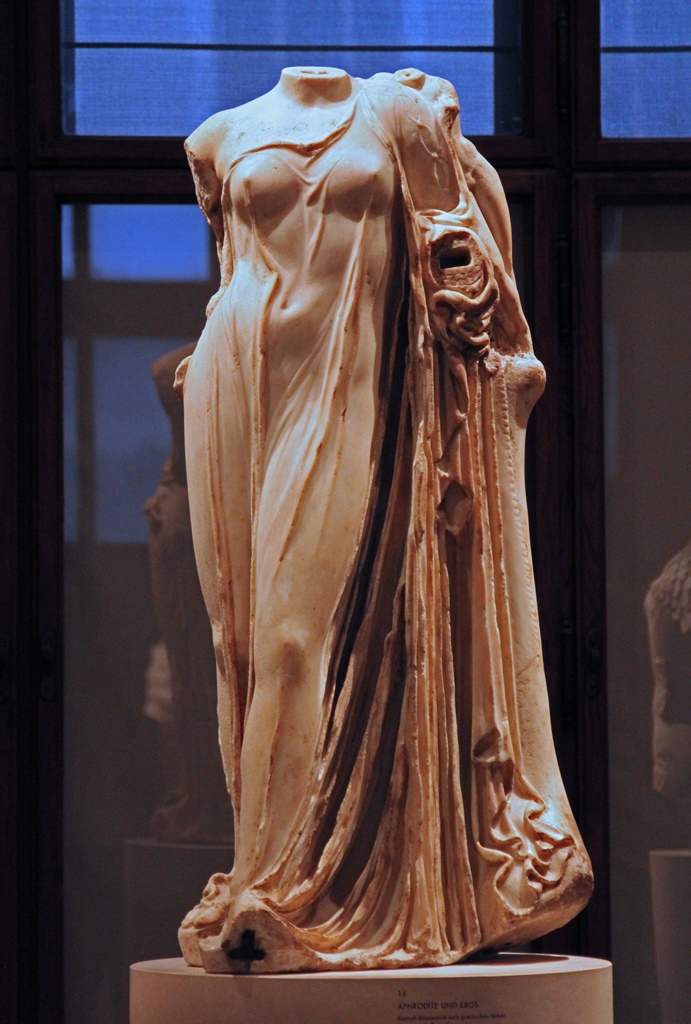
Aphrodite and Eros, Roman(?) (1st C. B.C.(?))
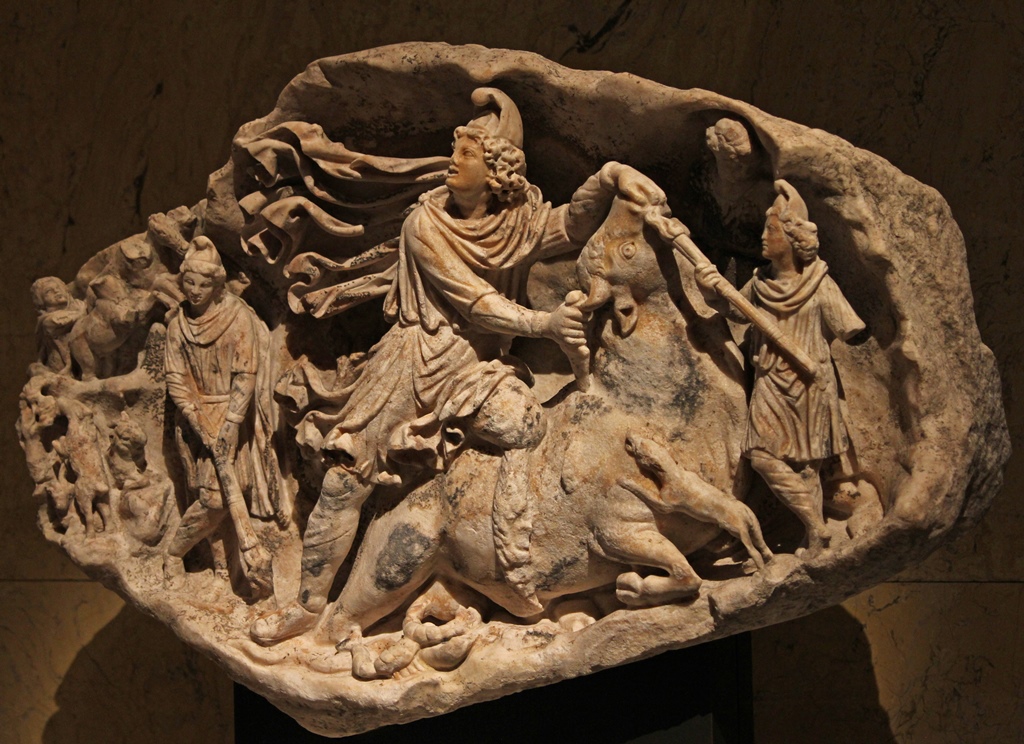
Relief of Mithras, Roman (2nd C. A.D.)
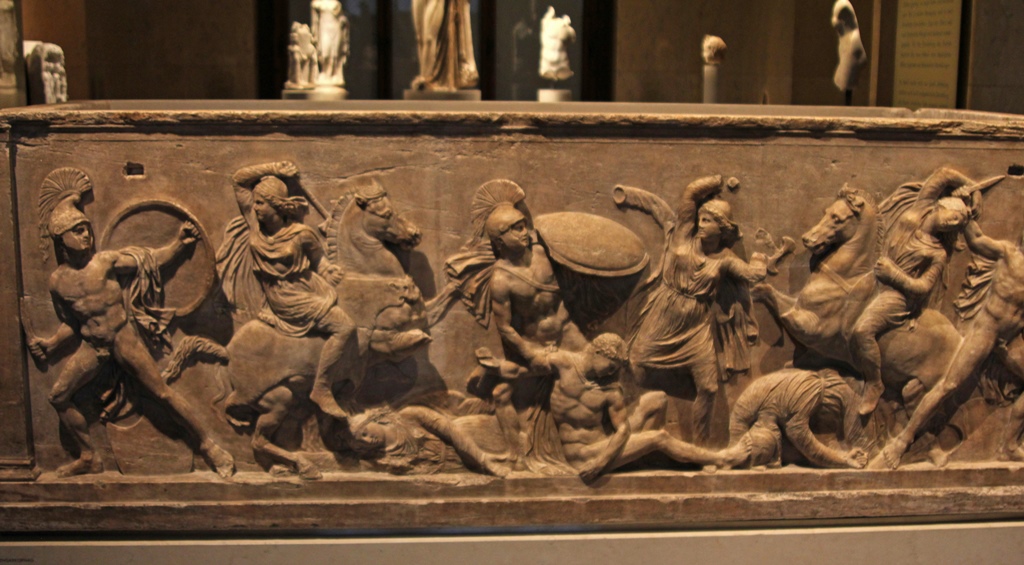
Amazon Sarcophagus, Greek (4th C. B.C.)
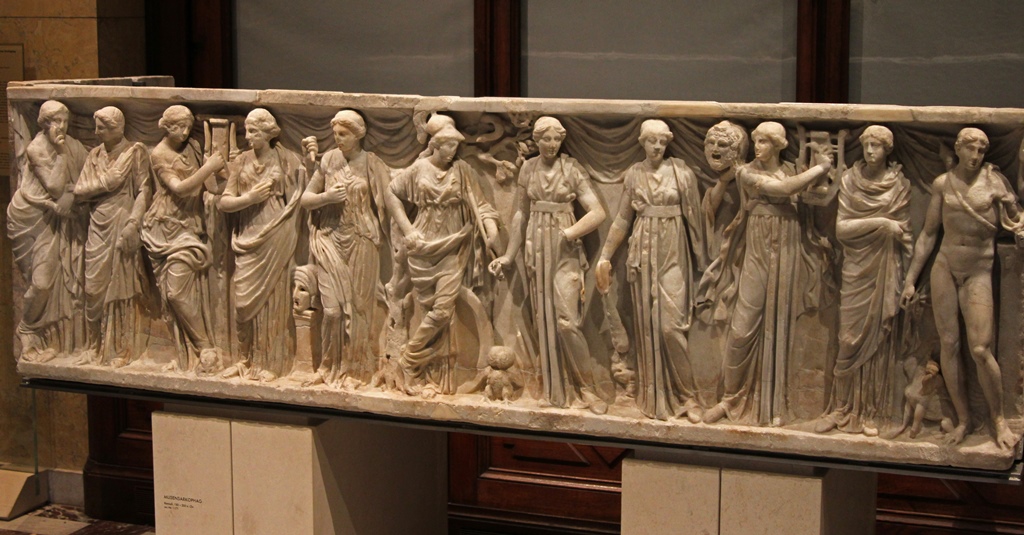
Sarcophagus with Nine Muses, Roman (180-200 A.D.)
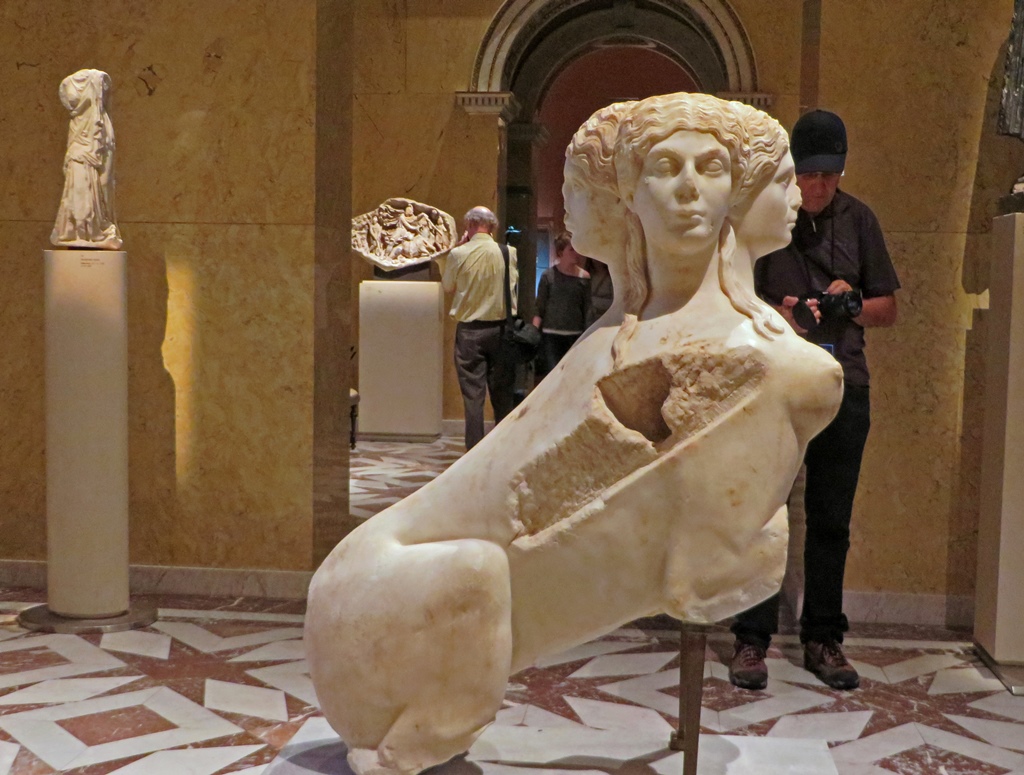
Four-Headed Sphinx, Roman (2nd C. A.D.)
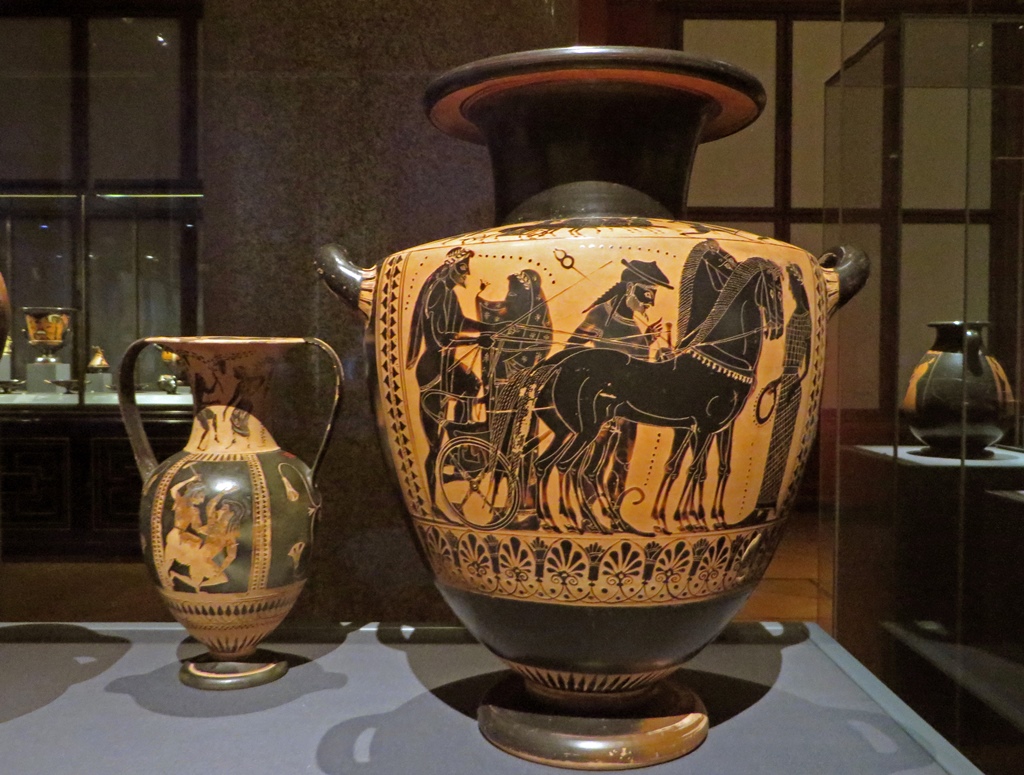
Greek Pottery
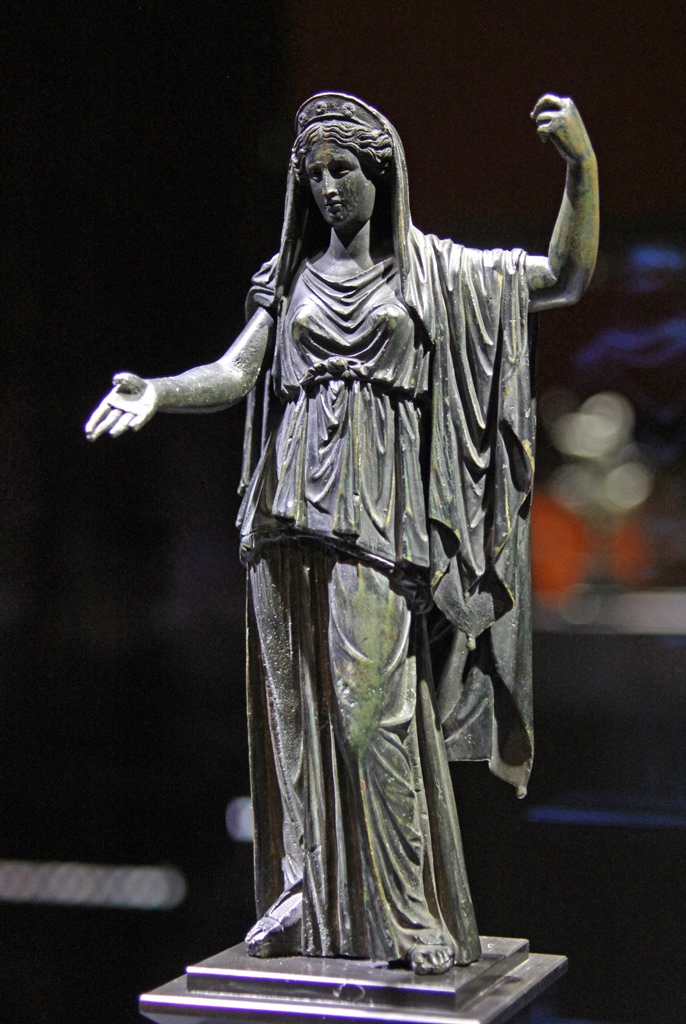
Juno, Roman
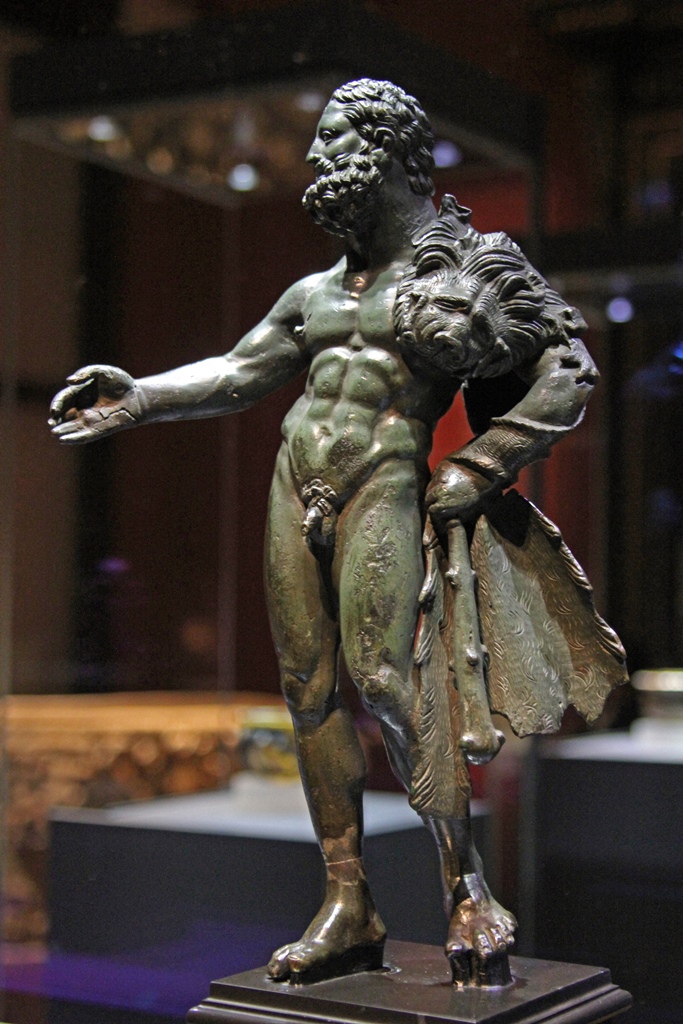
Hercules, Roman (2nd C. A.D.)
Model of Temple in Paestum, Carlo Albacini (1805)
But what about the paintings? Doesn't an art museum have to have paintings?
Well, not necessarily. But the Kunsthistorisches Museum has plenty. They're
upstairs. The stairs are easy to find – they're directly forward from the
entrance. And they're decorated to the hilt, so they're hard to miss. The
main decoration is a sculptural group by Antonio Canova depicting Theseus
and the Centaur in an epic struggle, found dead-center, on the first
landing. Canova completed this statue in 1819, and for decades it was on
display in a Greek-style temple (completed in 1823, called the Theseus
Temple) in the Volksgarten. In 1890 the statue was moved to the nearly-finished
Kunsthistorisches Museum (Theseus's arm was apparently broken in the process,
but was quickly repaired) and the temple was slated for demolition. But
apparently the demolition was postponed, as the temple is still there and being
used for exhibitions of contemporary art. And Theseus (and his arm) is on the
first landing of the Kunsthistorisches Museum stairway, presiding over the entry
into the Land of Paintings.
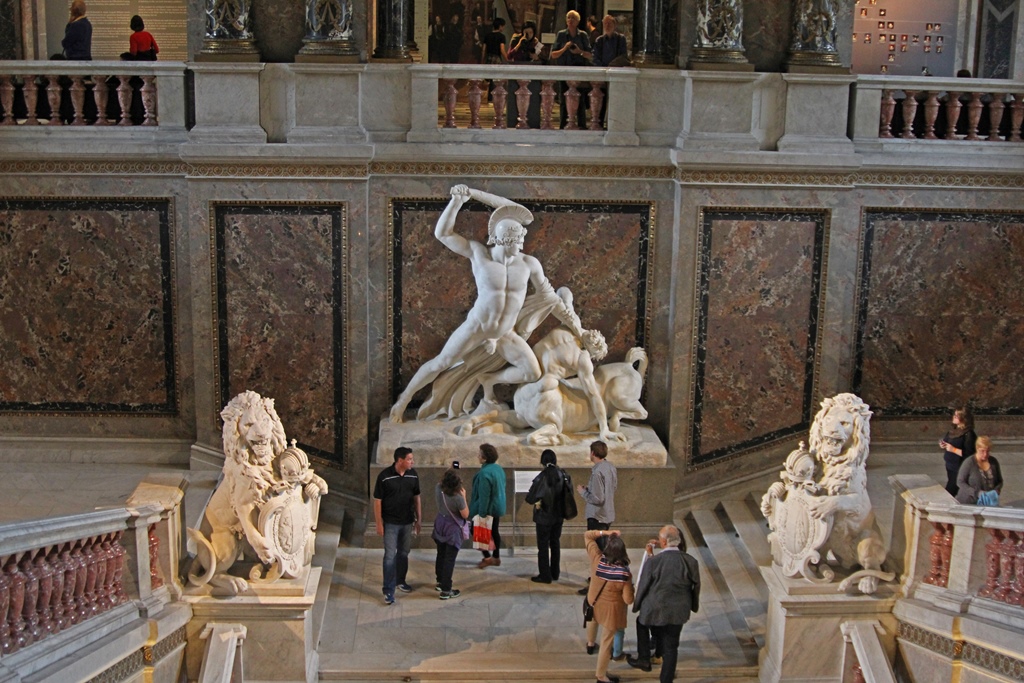
Theseus Defeats the Centaur, Antonio Canova (1805-19)
But before investigating the paintings, we noticed what appeared to be a
café through an archway in front of us. We walked in to take a look and found
ourselves underneath the building's octagonal dome, in an area known as Cupola
Hall which also happens to be a café. Several archways radiate from Cupola Hall,
some leading to paintings and others to hallways. Cupola Hall itself was replete
with marble, gilded accents and statuary, and it looked like a nice place to take
a break. So we did.
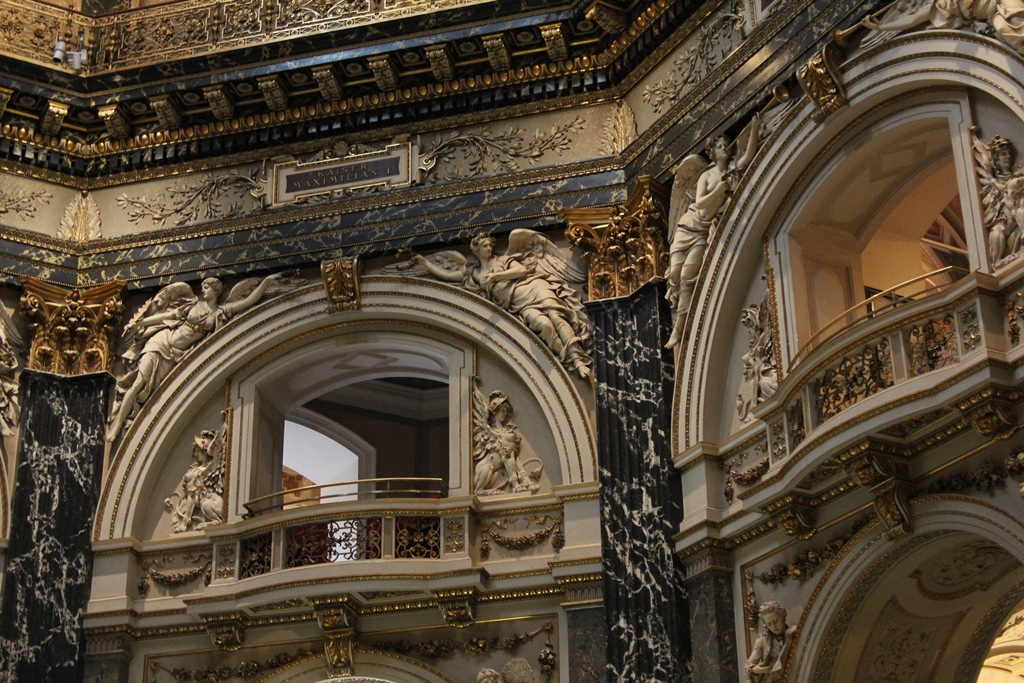
Inside Central Dome
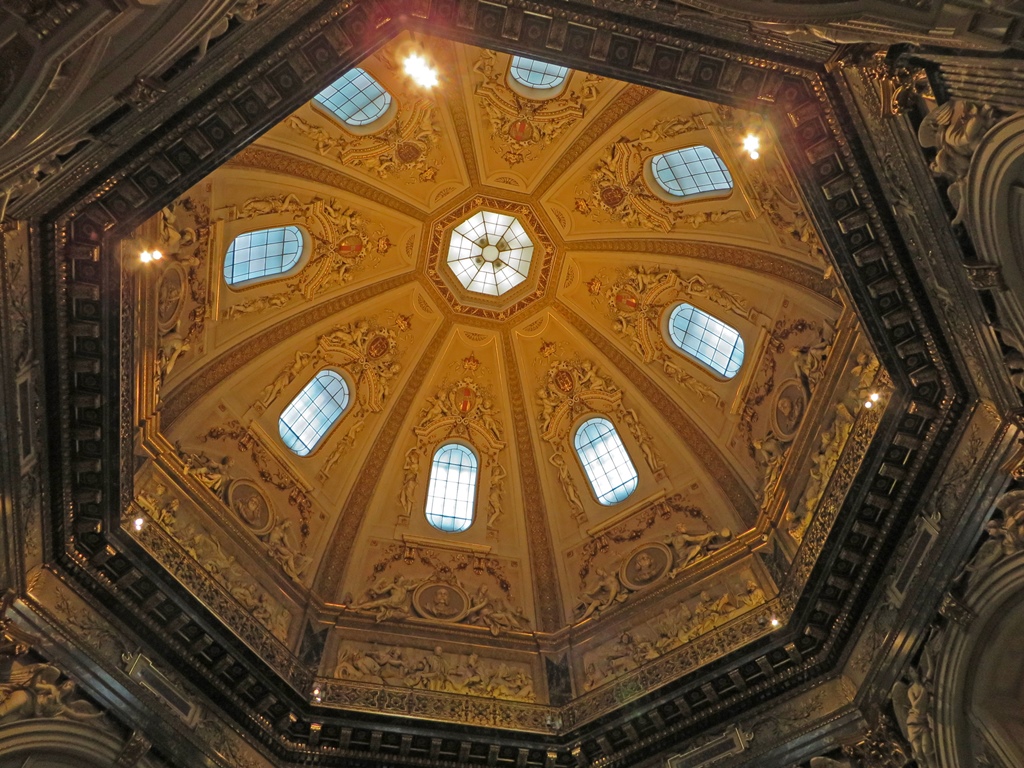
Central Dome
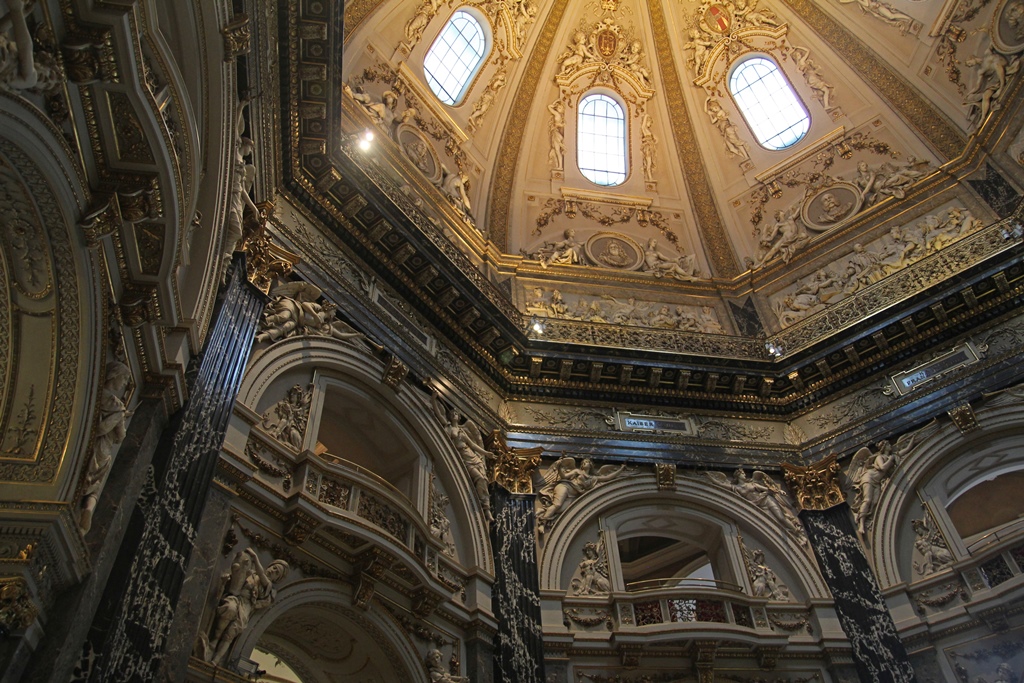
Under the Dome
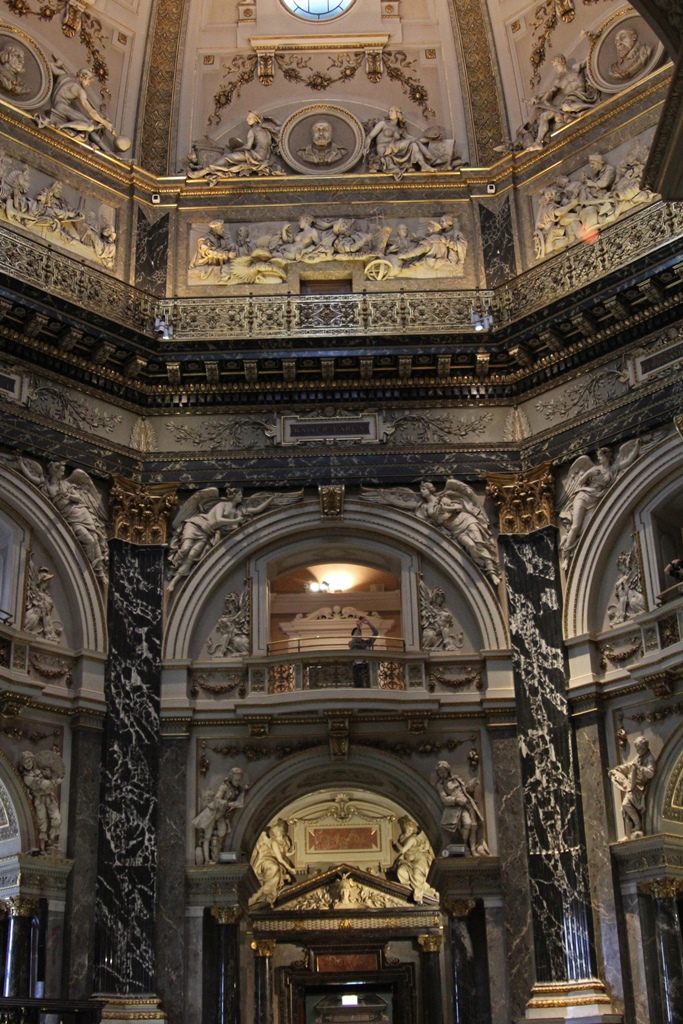
Charles V Archway
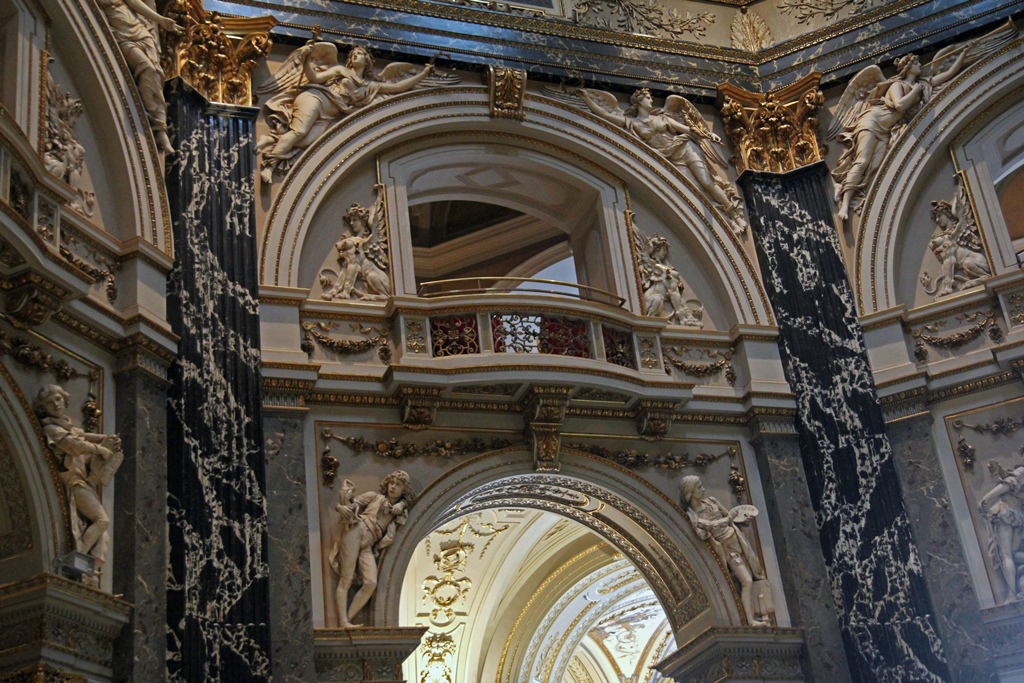
Charles VI Archway
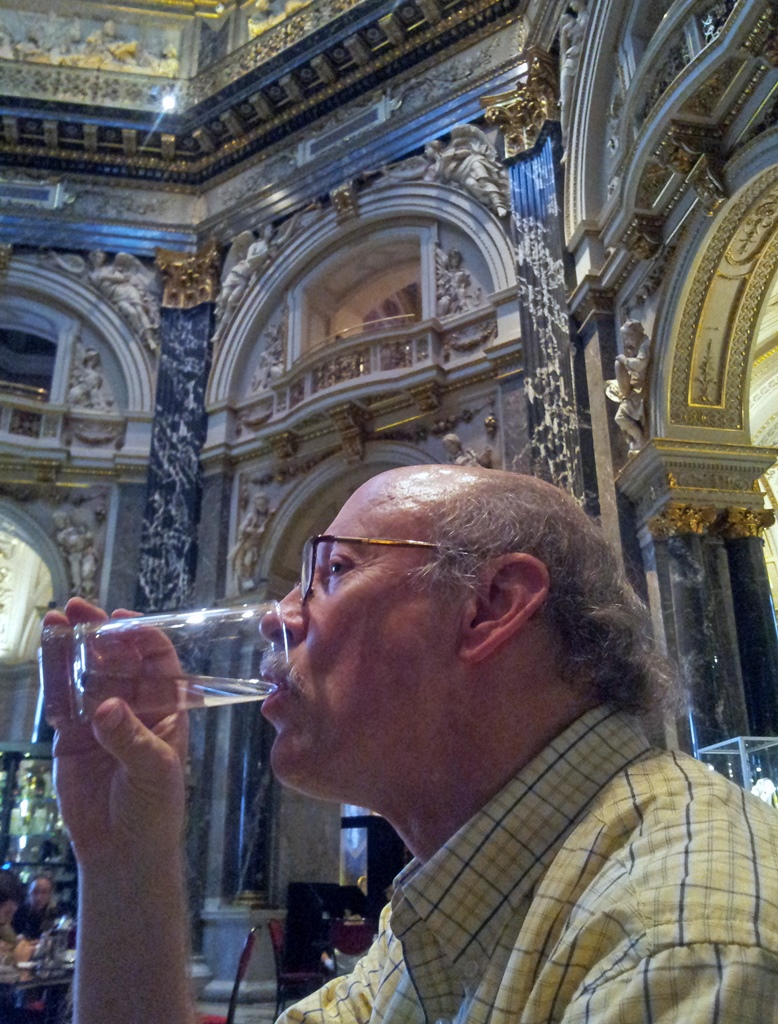
Bob in Café
The museum's collection of paintings is almost completely a result of acquisitions
by Habsburg emperors and archdukes. Unlike the collections discussed above, the
collection of paintings was essentially complete by the end of the 18th Century.
Additions to the collection were minimal after this time, and in fact there were
significant losses during Napoleon's occupation of Vienna in 1809. Prior to this
time, the still-growing collection was housed in the Stallburg, a part of the
Hofburg palace (now used by the Spanish Riding School to house Lipizzaner horses),
but in 1776 was moved by Maria Theresa to the Upper Belvedere palace outside the
city walls. While at the Belvedere, the collection was organized according to
innovative principles that are still followed by modern art museums today, and it
was opened for viewing by the public. Like the other collections, the paintings
were moved in 1891 to the new Kunsthistorisches Museum. The collection reflects
the tastes of its collectors, consisting mainly of paintings from Italy, Flanders,
the Netherlands, Germany and Spain.
A note on visiting the Kunsthistorisches Museum: If you're mainly interested in
seeing the paintings, you should go directly upstairs and look at them first, and
work your way back down if you have the time. If you do it the other way around,
there's a chance you could run out of time before seeing all the paintings. The
museum closes at 6 PM on most days, and they insist on everyone being physically
out of the building before 6. In our case, we didn't see quite everything we
wanted to see, but we did see a lot. Still, it was a bad feeling to start
understanding how much remained to be seen and how little time there was to see
it. A revisit may be in order. But here's some of what we were able to see.
First, some of the Italian paintings:
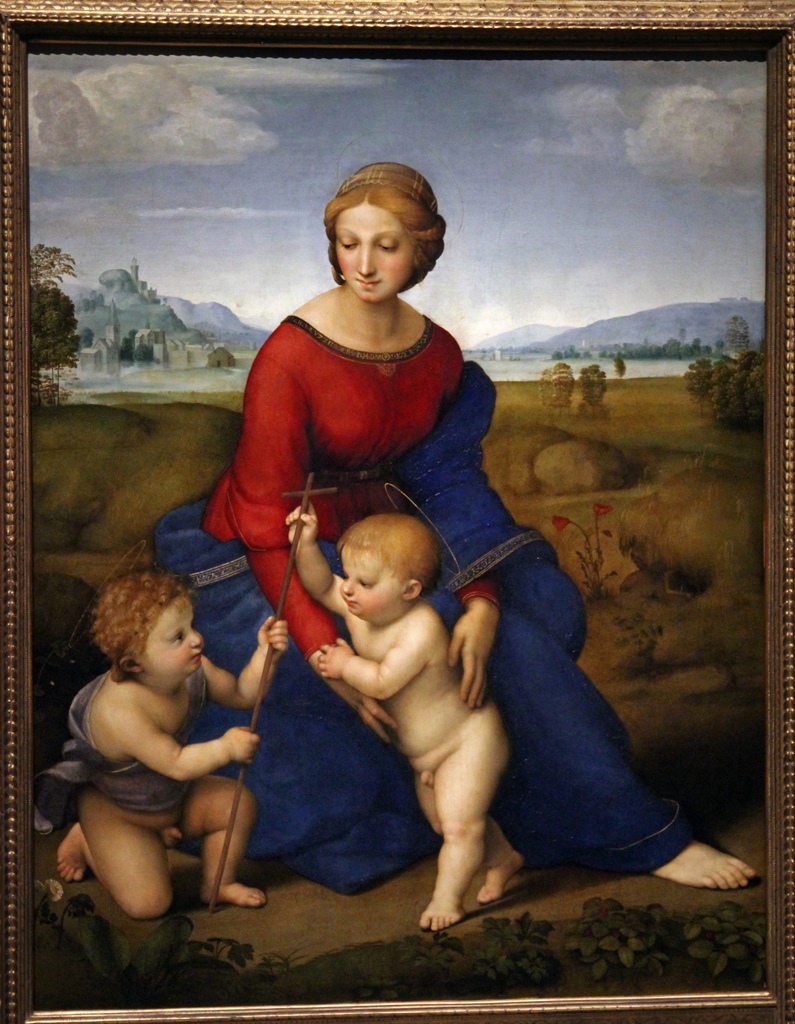
Madonna of the Meadow, Raphael (1505-06)
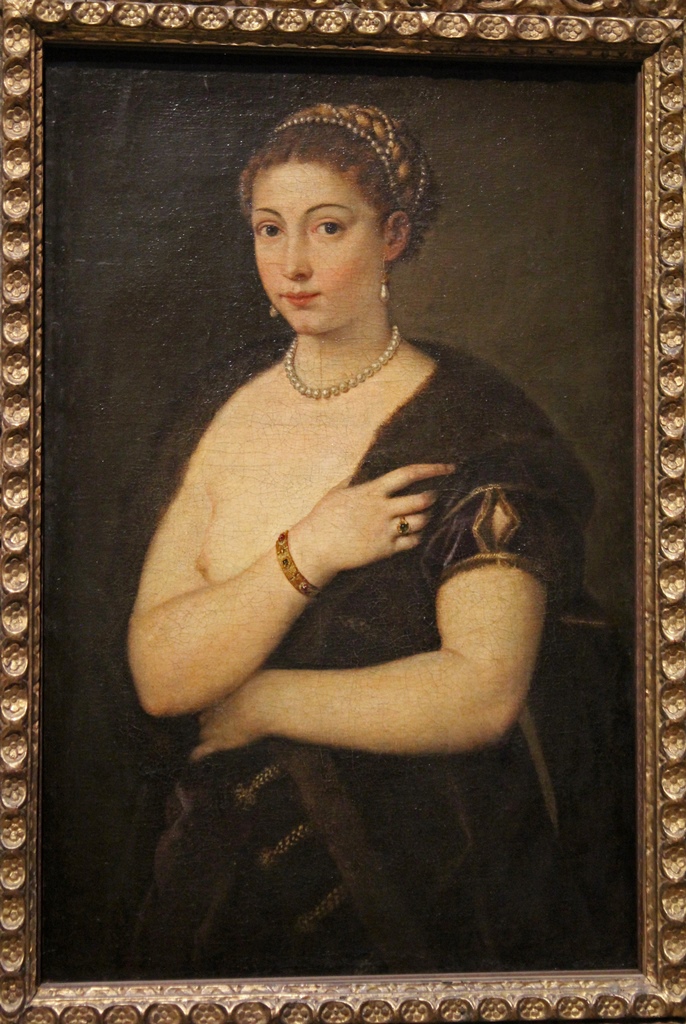
Girl in a Fur, Titian (ca. 1535)
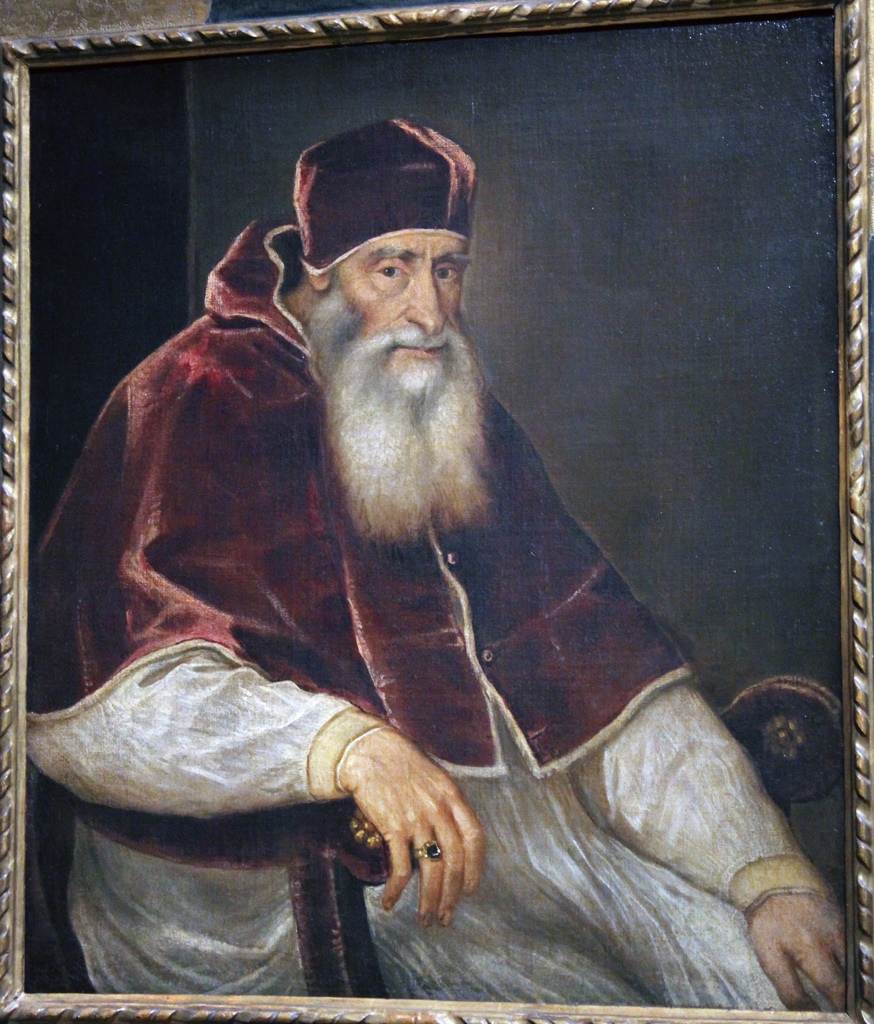
Pope Paul III, Titian (after 1546)
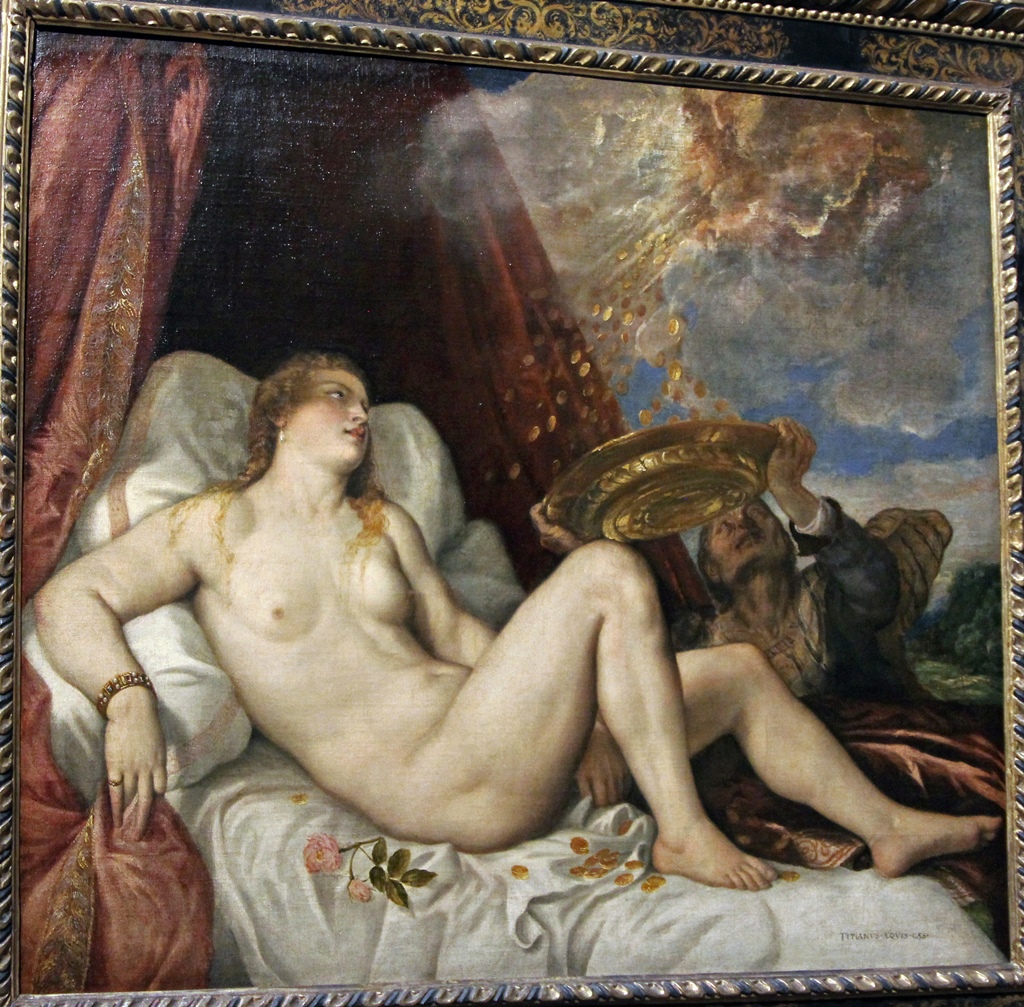
Danaë, Titian (after 1554)
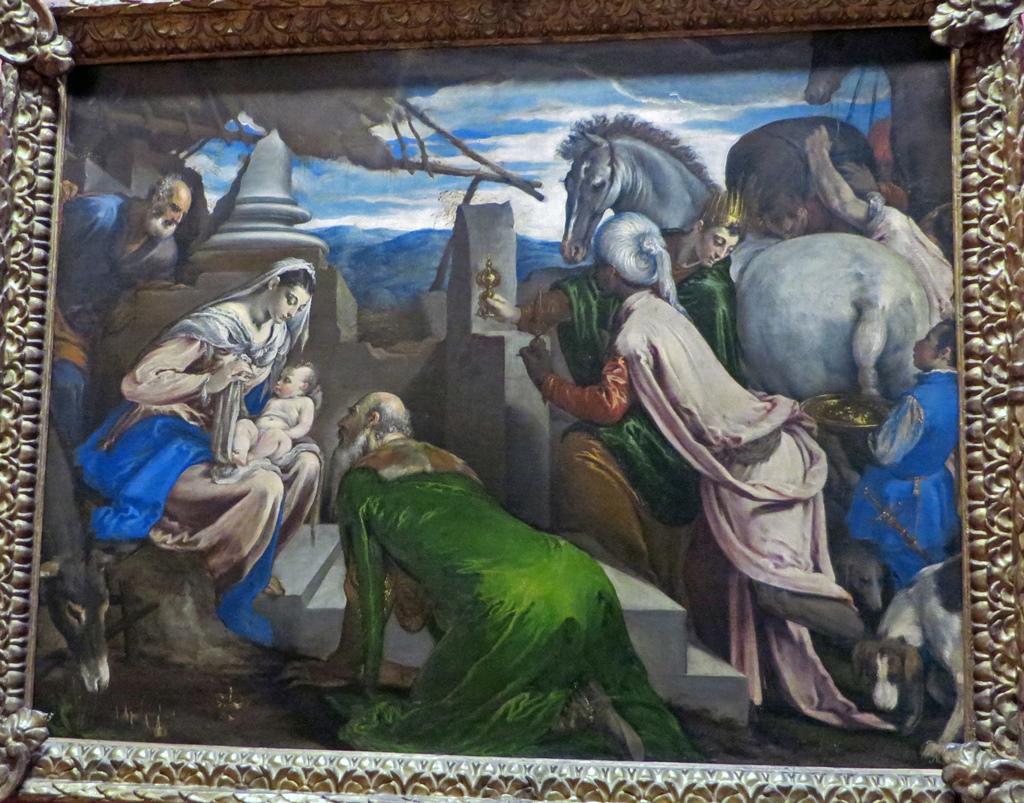
Adoration of the Magi, Jacopo Bassano (ca. 1555-60)
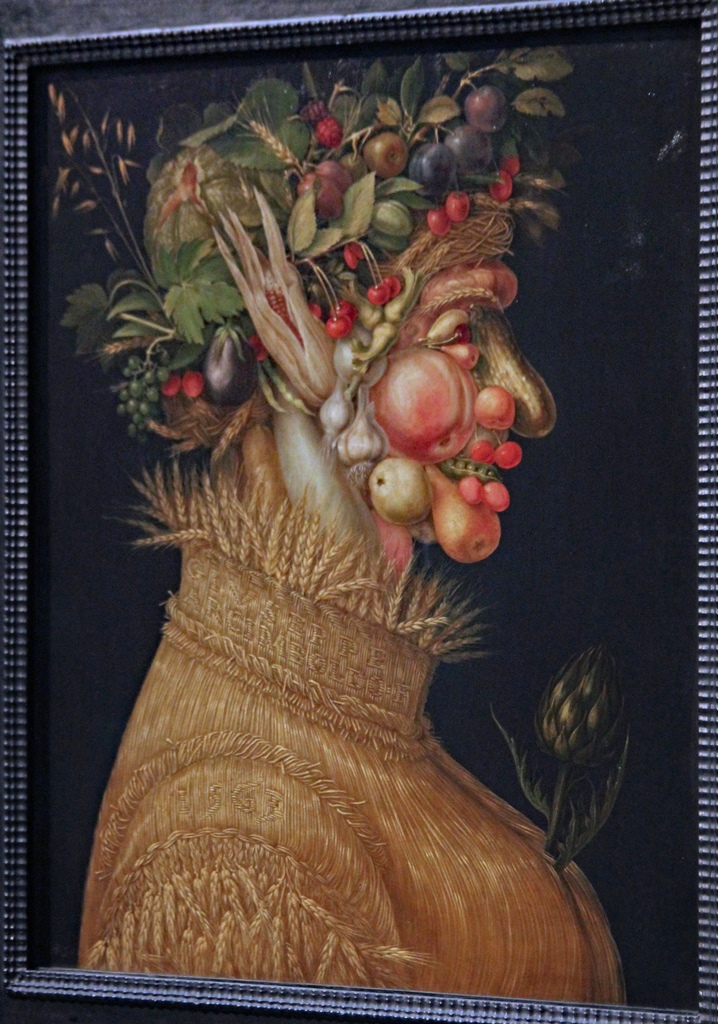
Summer, Giuseppe Arcimboldo (1563)
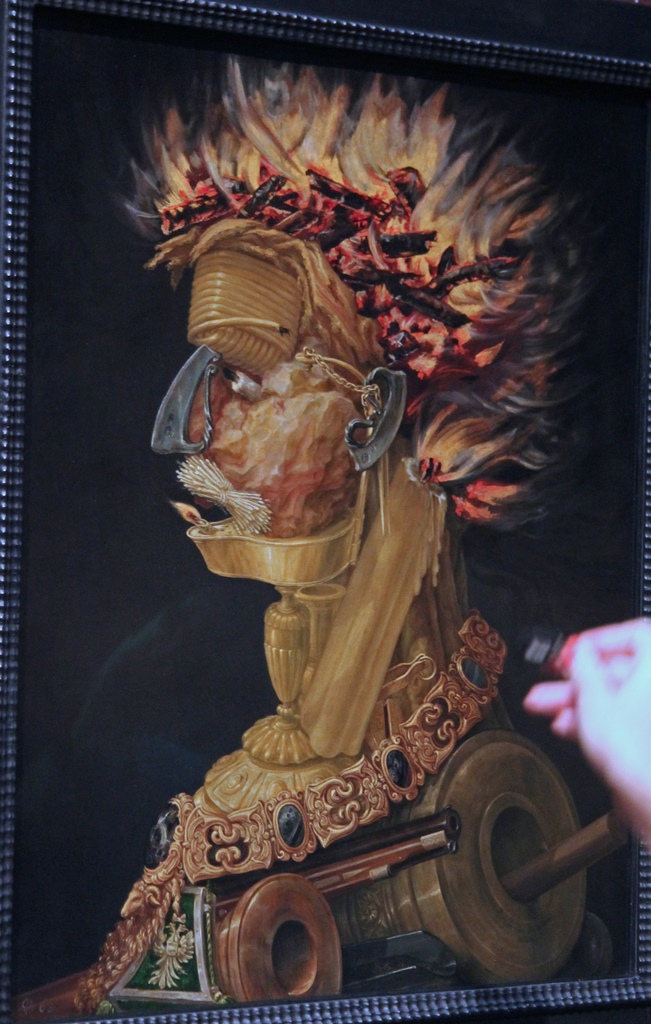
Fire, Giuseppe Arcimboldo (1566)
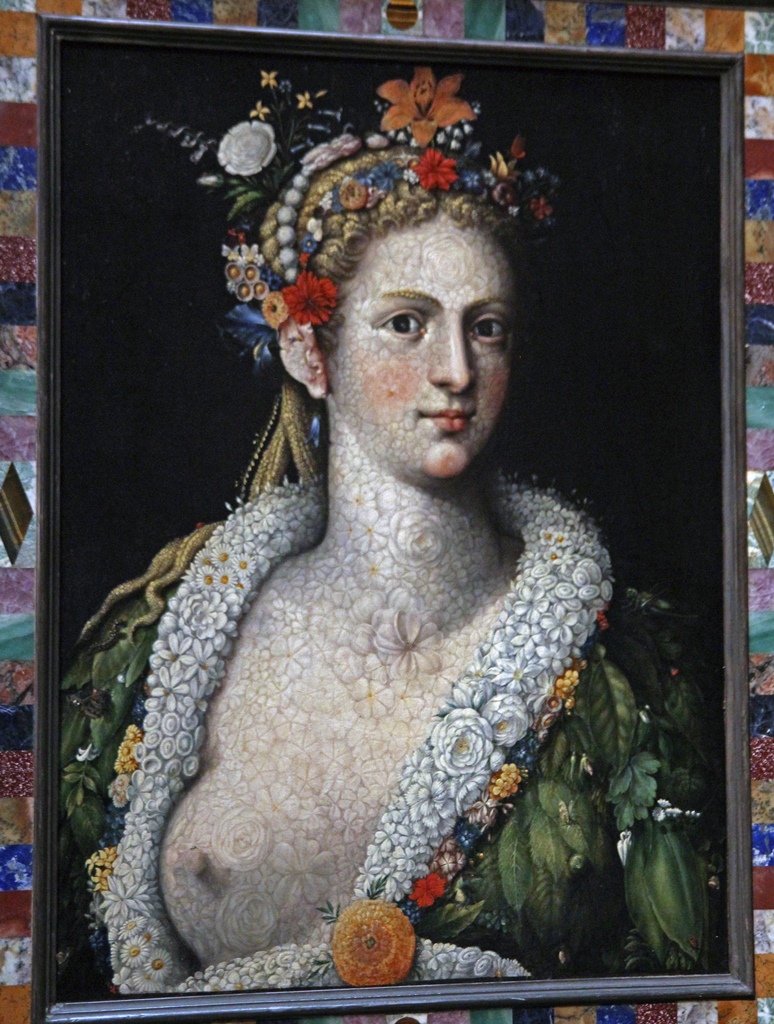
Flora Meretrix, Giuseppe Arcimboldo (ca. 1590)
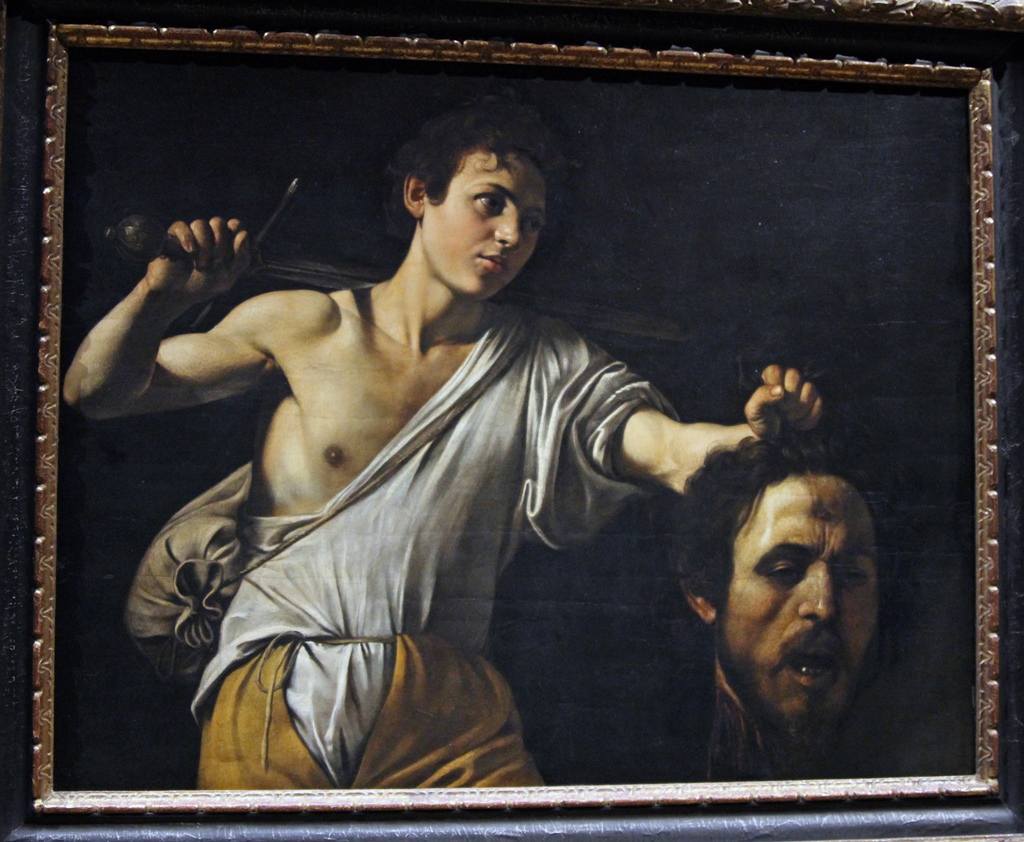
David with Goliath's Head, Caravaggio (ca. 1600-01)
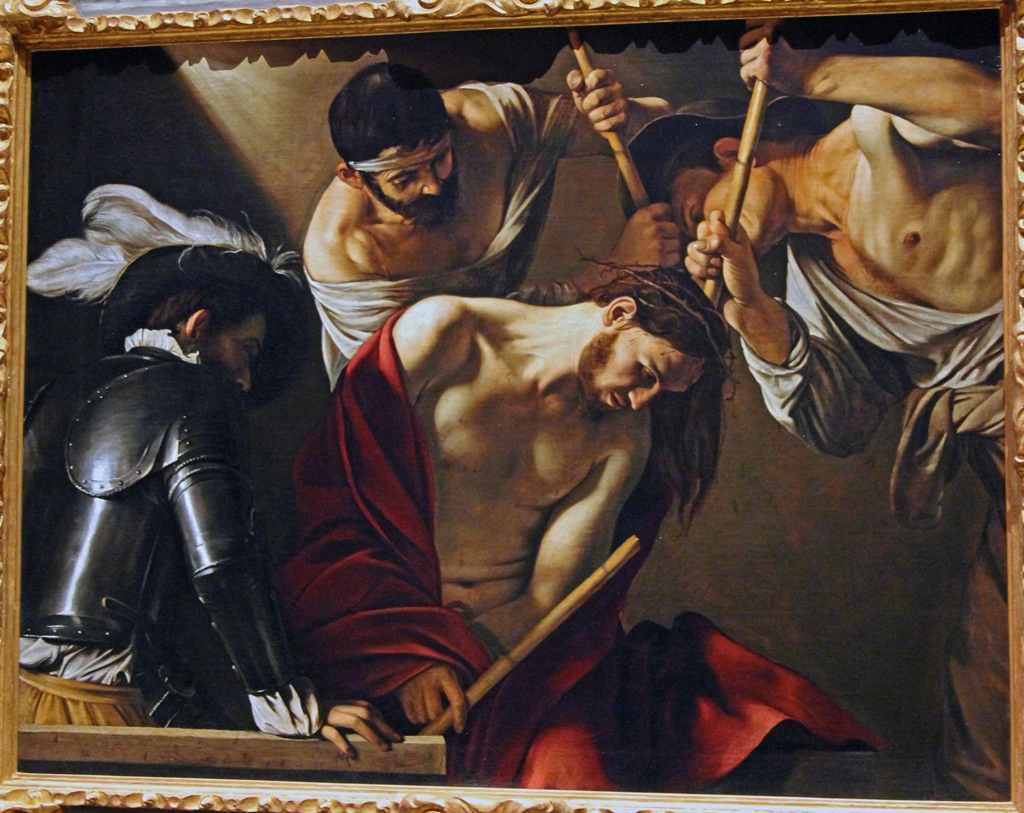
The Crowning with Thorns, Caravaggio (ca. 1603)
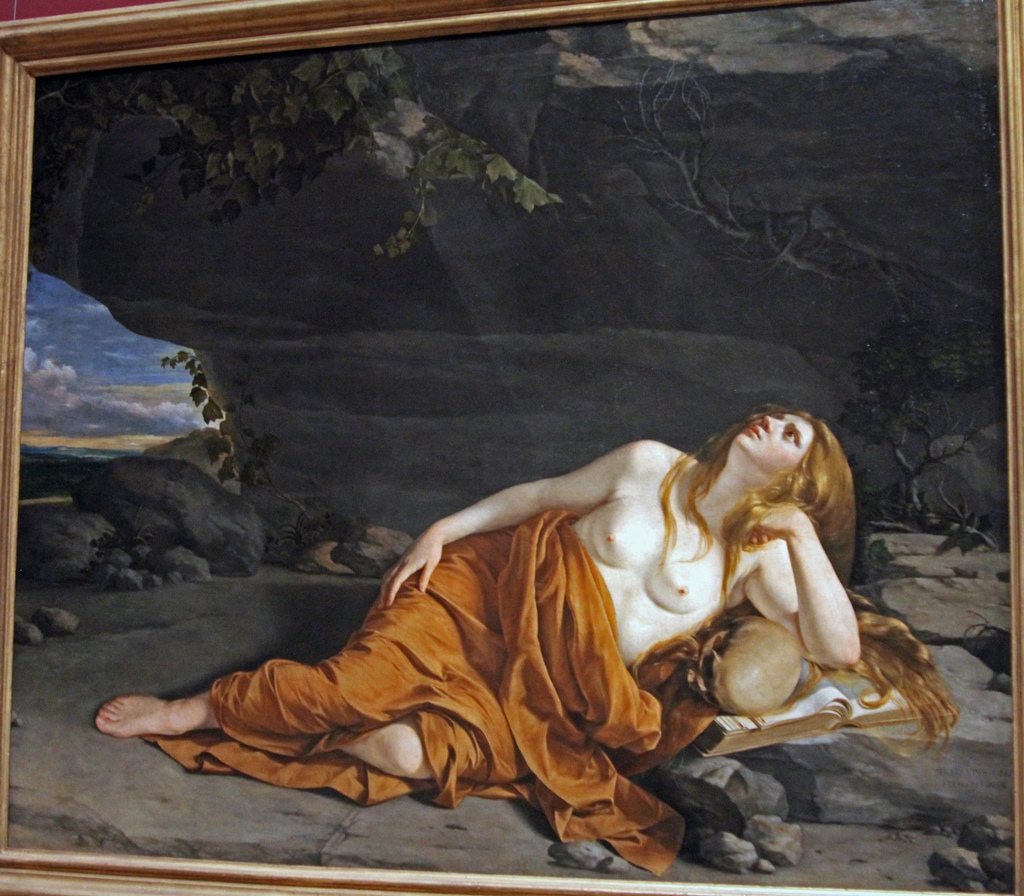
The Penitent Mary Magdalene, Orazio Lomi Gentileschi (ca. 1622-28)
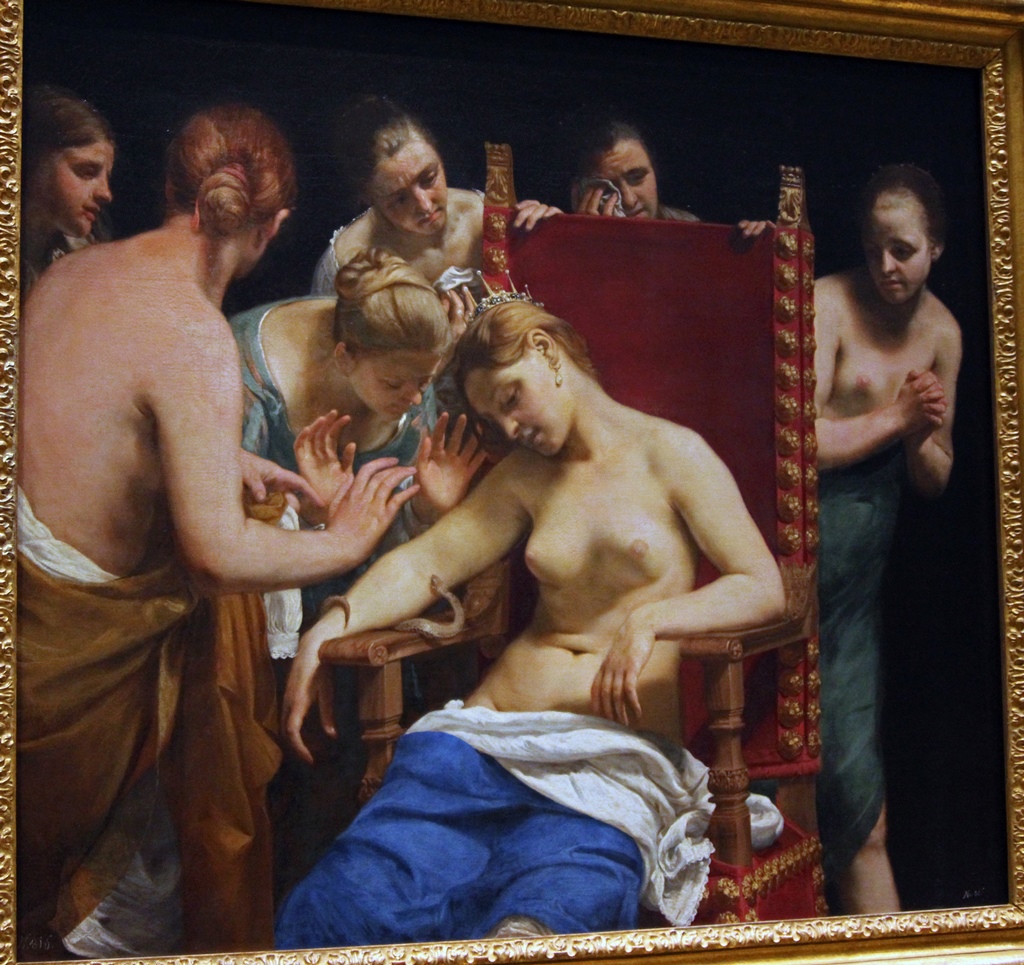
The Suicide of Cleopatra, Guido Cagnacci (1661-62)
St. Michael Vanquishing the Devils, Luca Giordano (ca. 1664)
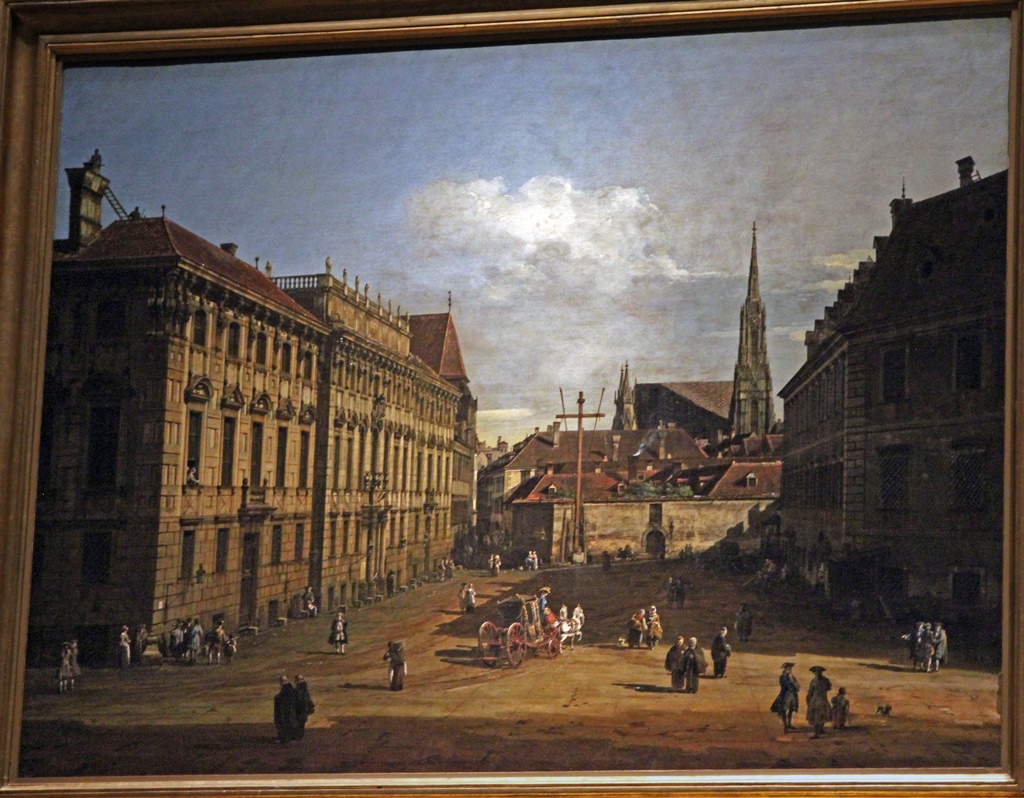
Dominican Church, Vienna, Canaletto (1758-61)
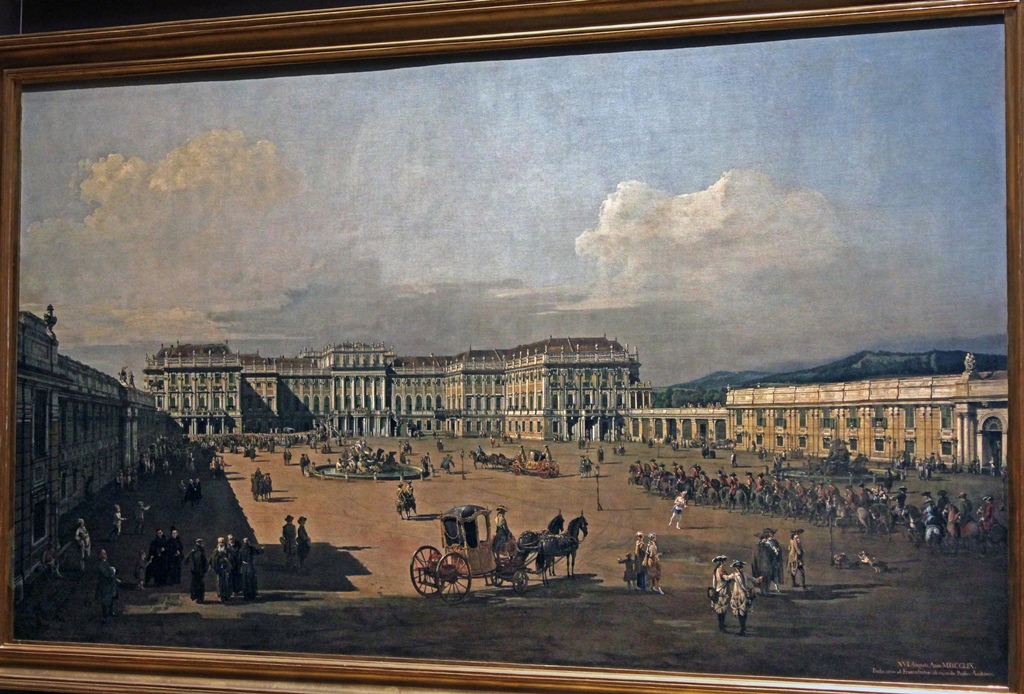
Schönbrunn Palace: Court Façade, Canaletto (1759-61)
Next, some paintings by Spaniards:
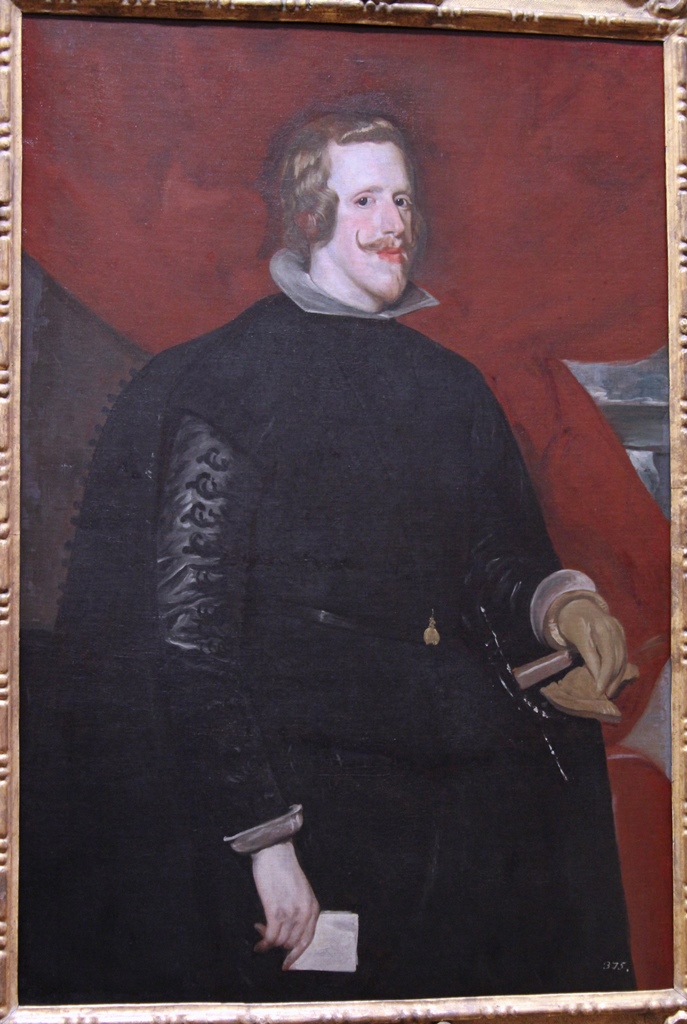
King Philip IV of Spain, Diego Velázquez (1632)
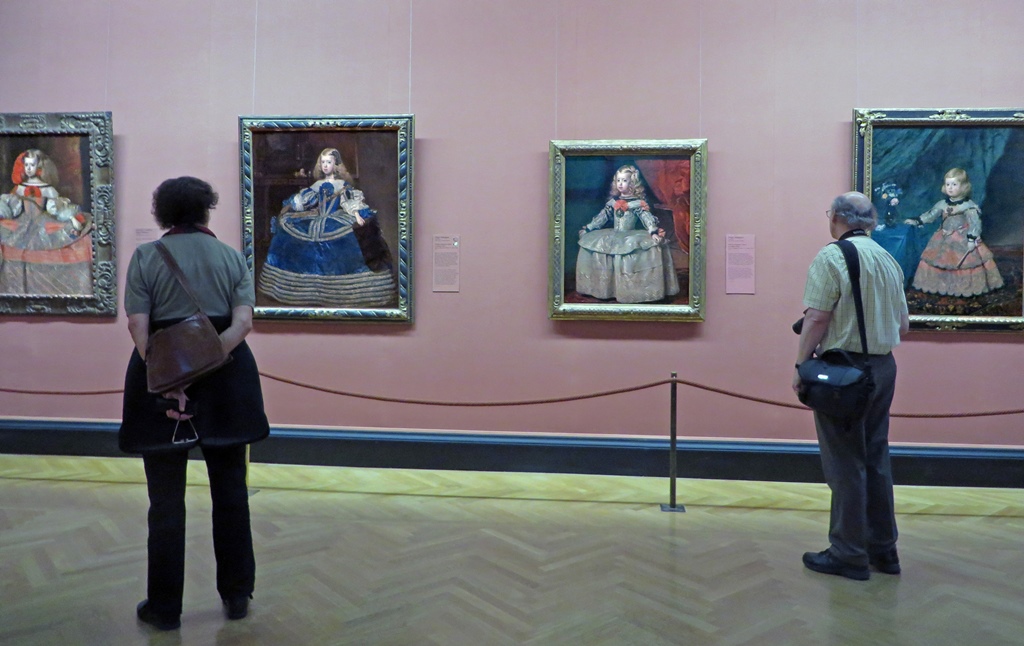
Bob and Spanish Princesses
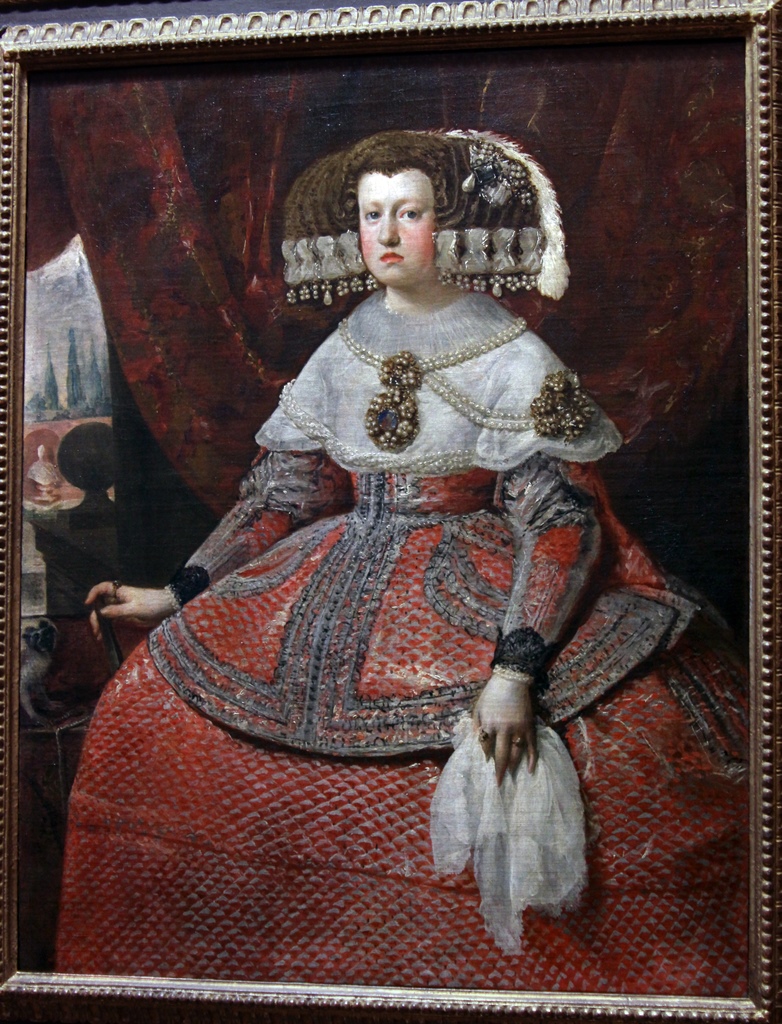
Queen Mariana in a Bright Red Dress, Diego Velázquez and Workshop (ca. 1655-60)
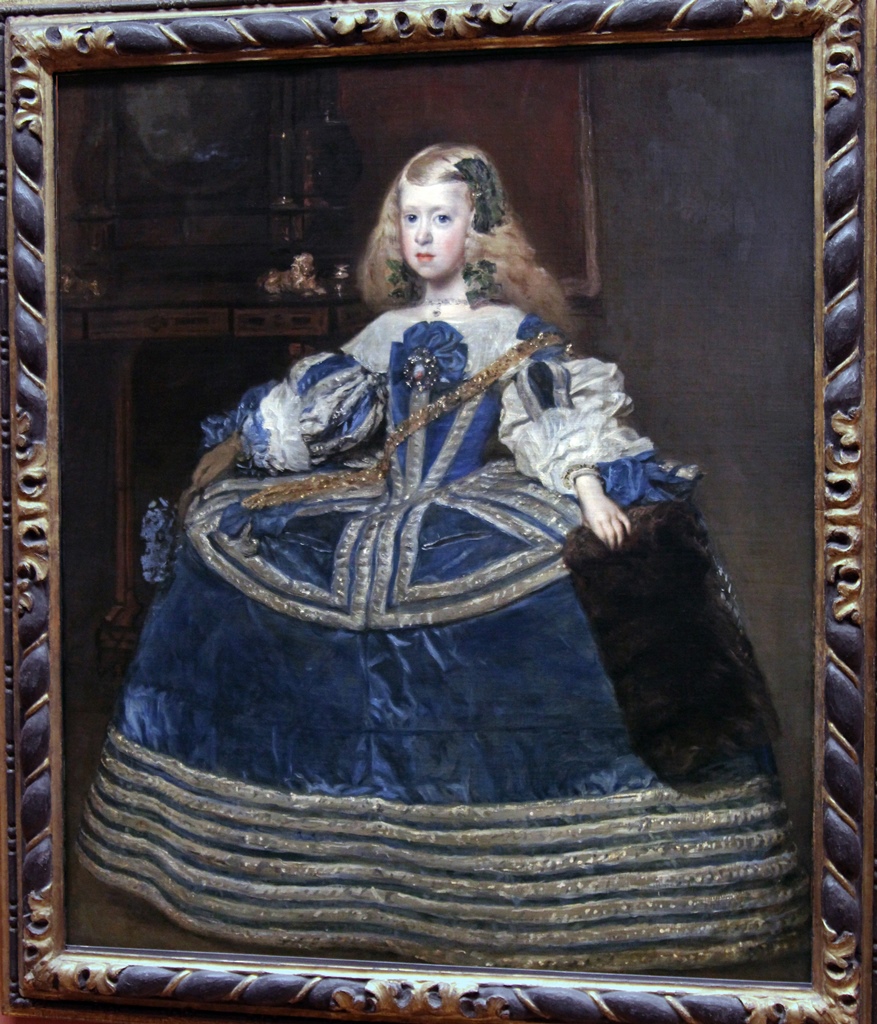
Infanta Margarita Teresa in a Blue Dress, Diego Velázquez (1659)
St. Michael, Esteban Bartolomé Murillo (1665-68)
A few from French artists:
Destruction of the Temple in Jerusalem by Titus, Nicolas Poussin (1638-39)
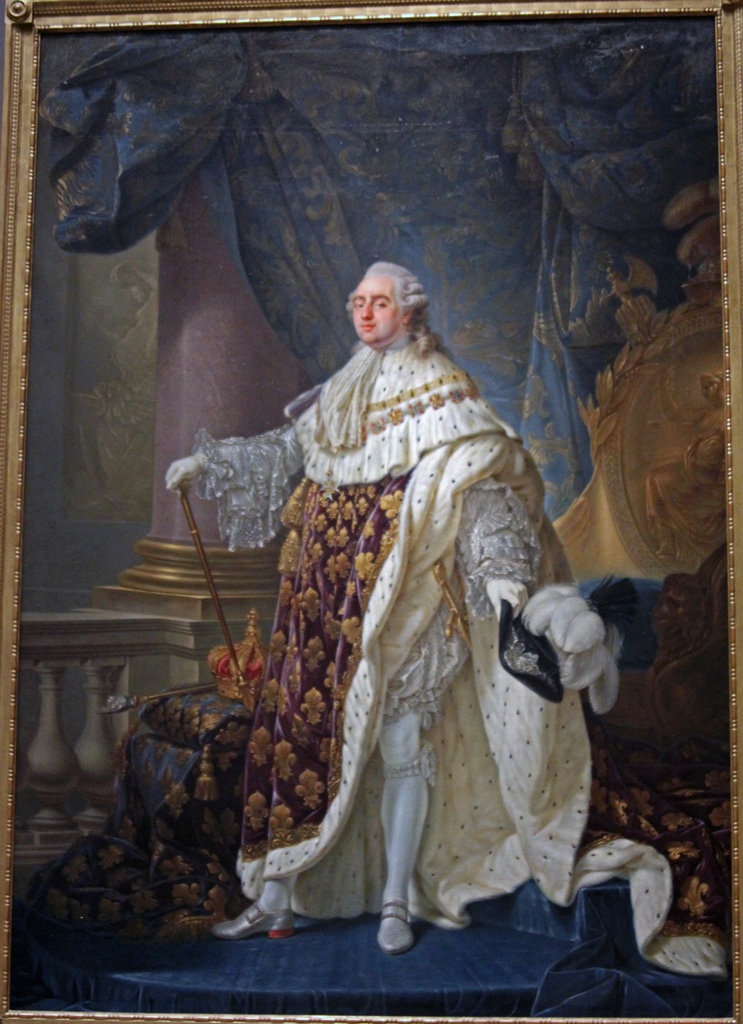
King Louis XVI of France in Coronation Robes, Antoine-François Callet (1781)
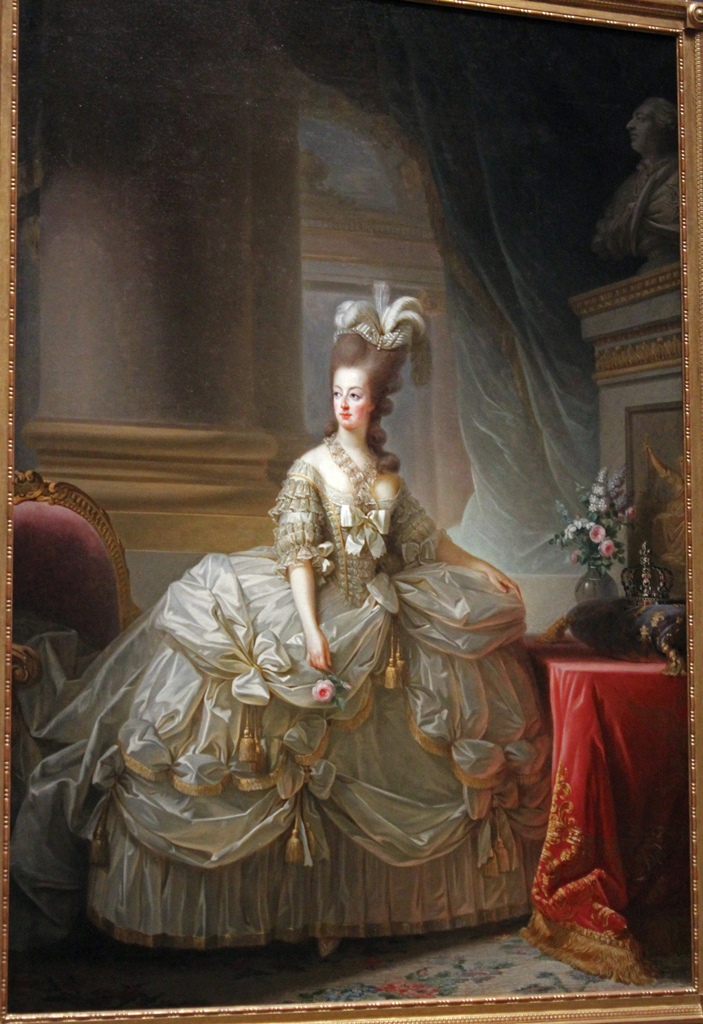
Archduchess Marie-Antoinette, Queen of France, Marie Louise Elisabeth Vigée-Lebrun (1778)
Some of the German paintngs:
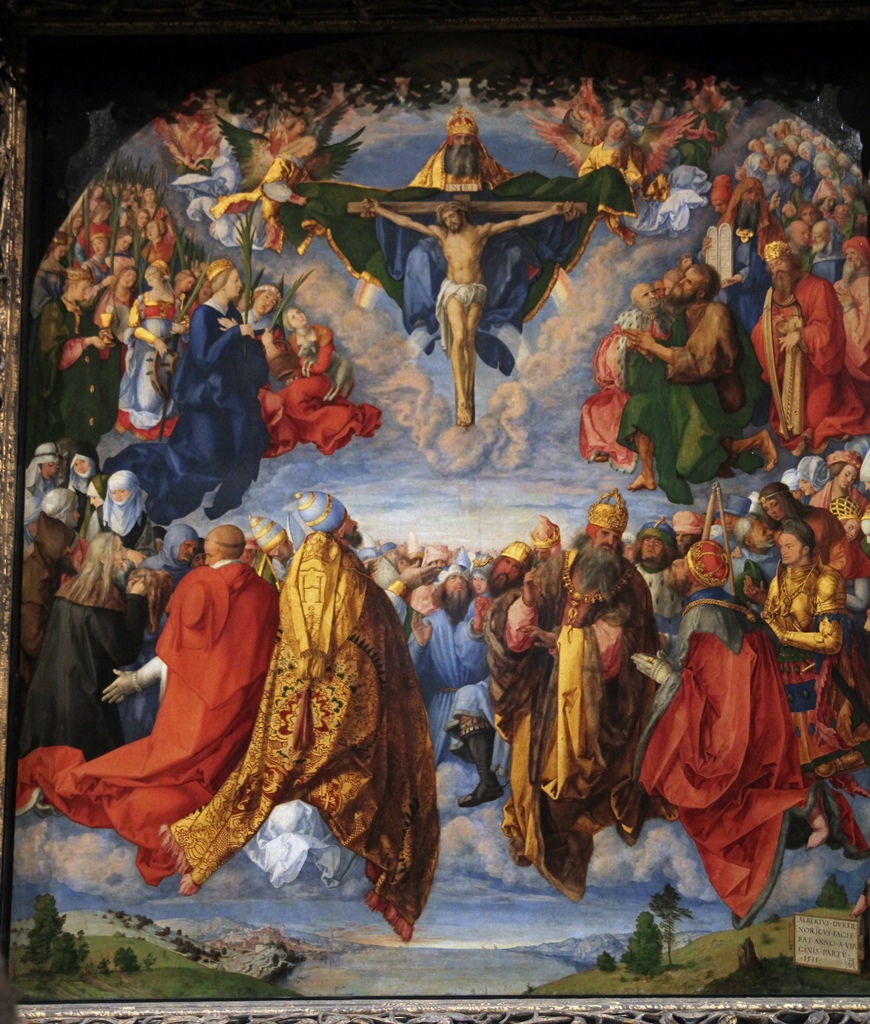
All Saints' Picture, Albrecht Dürer (1511)
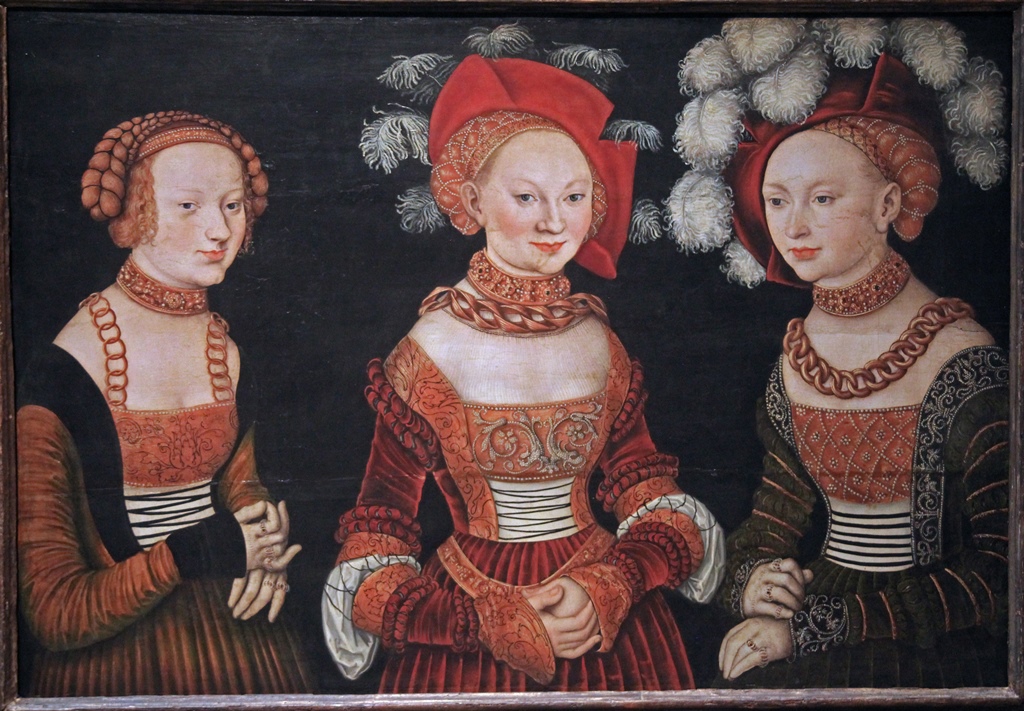
Sibylla, Emilia and Sidonia von Sachsen, Princesses of Saxony, Lucas Cranach the Elder (ca. 1535)
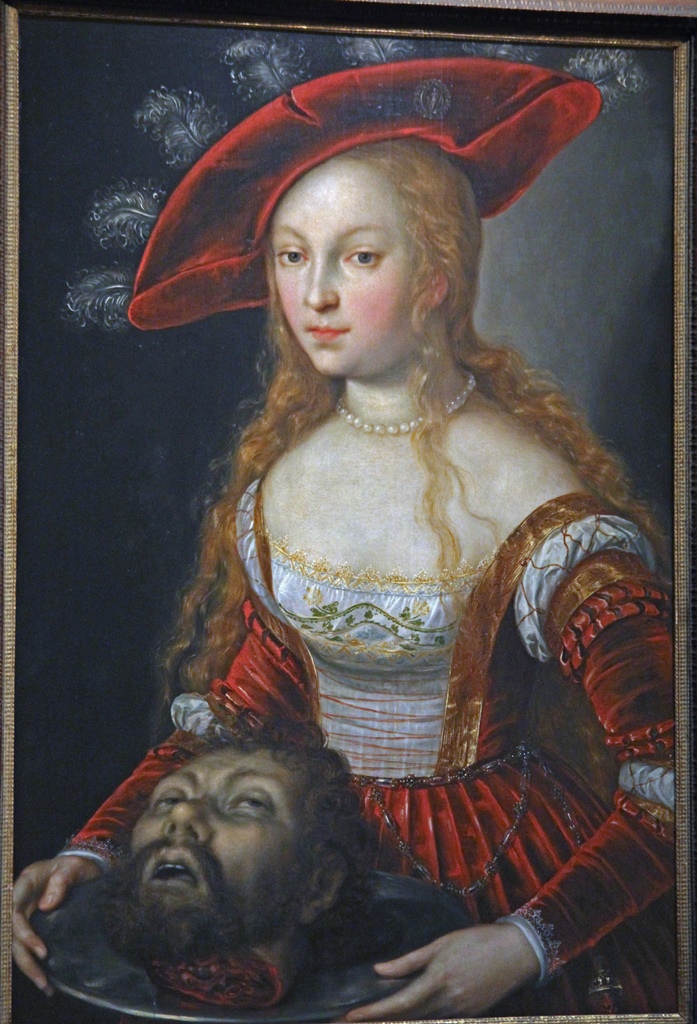
Salome with the Head of John the Baptist, Josef Heintz the Elder (ca. 1600-05)
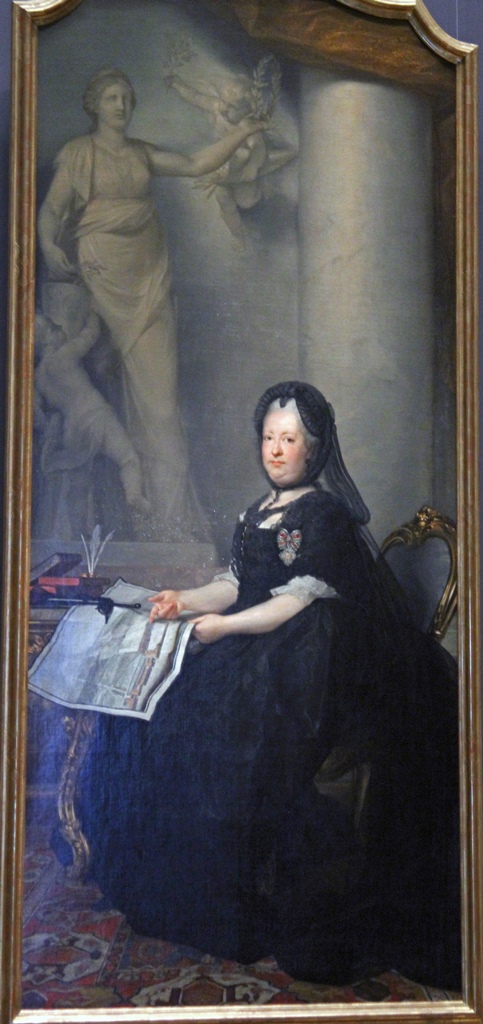
Maria Theresa as a Widow, Anton von Maron (1773)
And a few from the Low Countries:
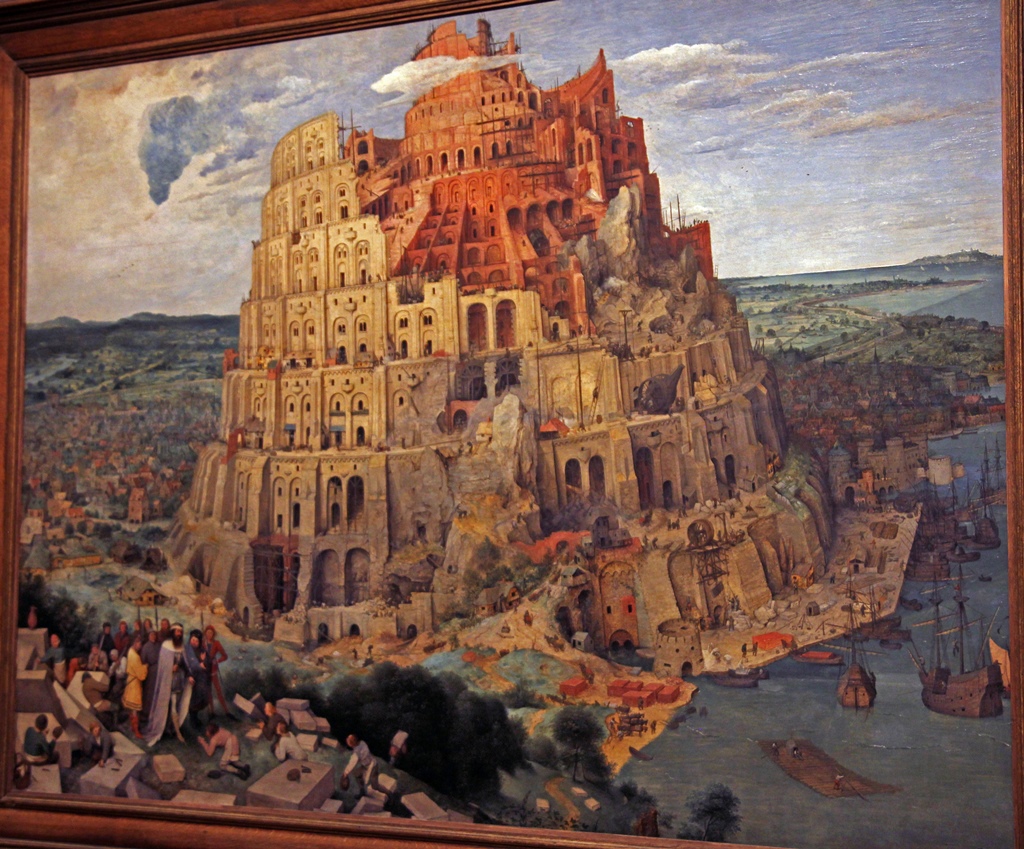
The Tower of Babel, Pieter Bruegel the Elder (1563)
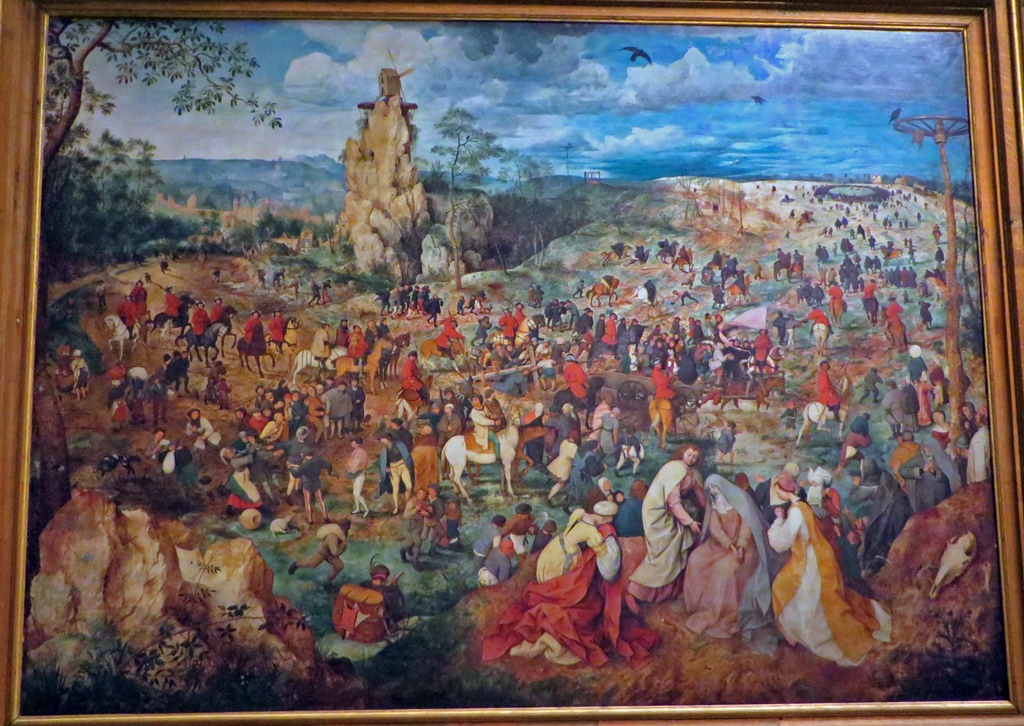
Carrying the Cross of Christ, Pieter Brueghel the Elder (1564)
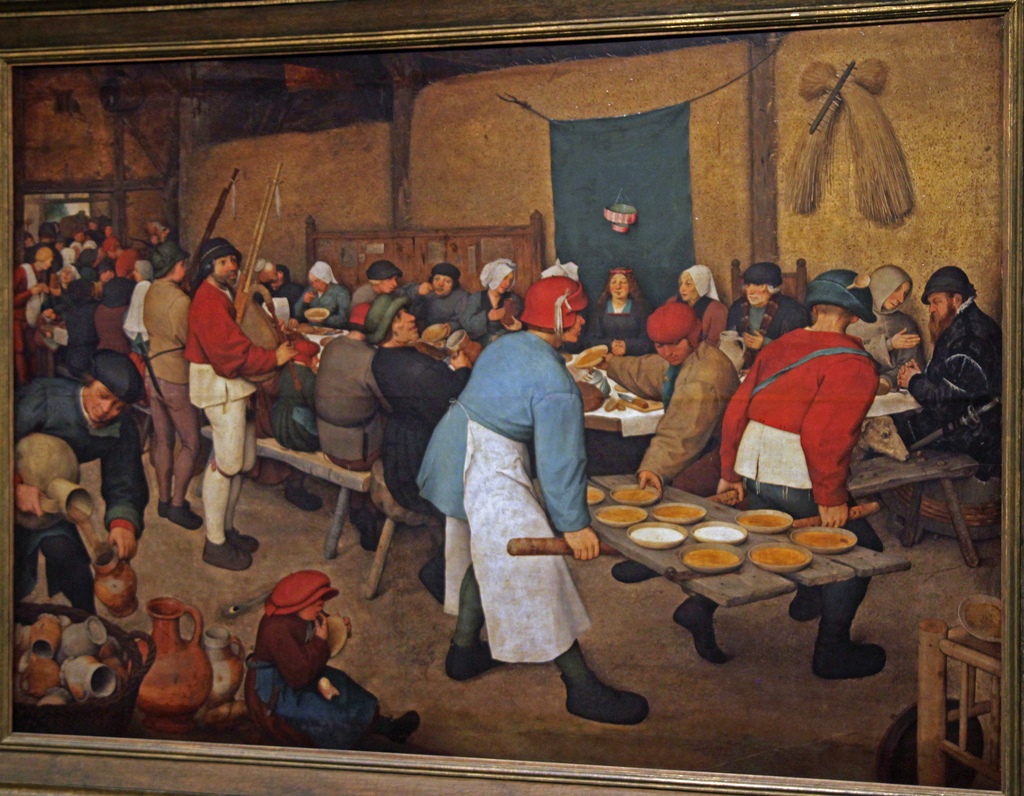
Peasant Wedding, Pieter Bruegel the Elder (ca. 1568)
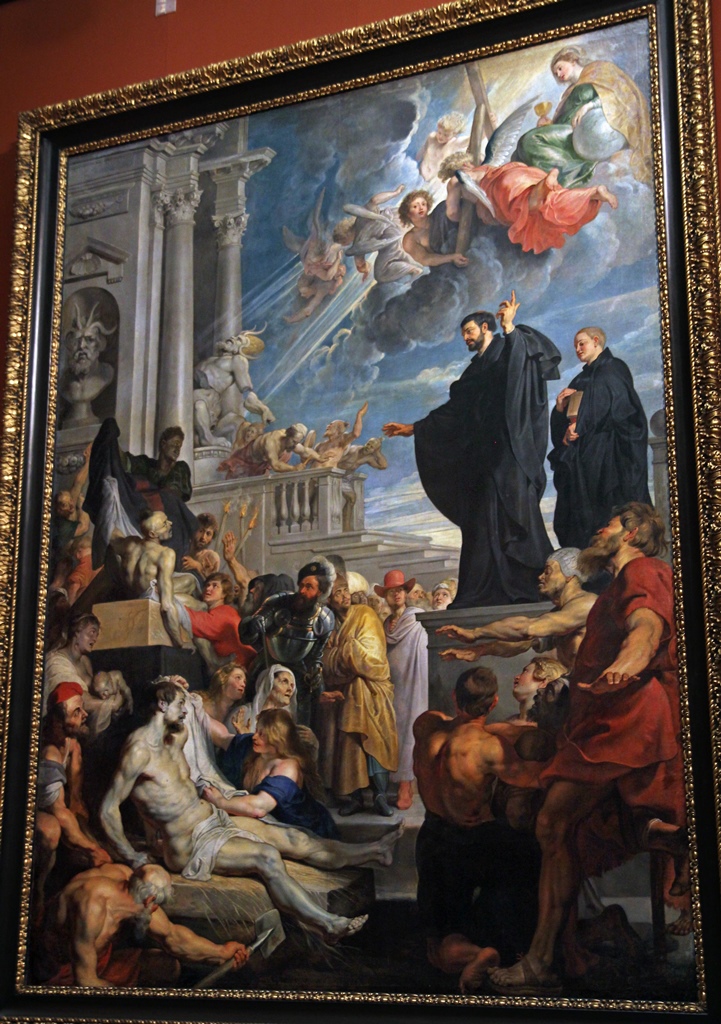
The Miracles of St. Francis Xavier, Peter Paul Rubens (ca. 1617-18)
Interior of the Jesuit Church in Antwerp, Sebastian Vrancx (ca. 1630)
At about 5:55, we found ourselves back out in Maria-Theresien Platz. The rain
had let up by this time, but we were pretty worn out. We returned to the hotel
and rested awhile. Eventually we located some seafood at the local Nordsee.
Nordsee on Kohlmarkt
After eating, we immediately went back to the hotel and got ready for bed. Again,
we had ambitious plans for the following day. We would start by venturing into
the bowels of the Hofburg Palace, to see the contents of the Imperial Treasury.
We were going to the Schatzkammer.

